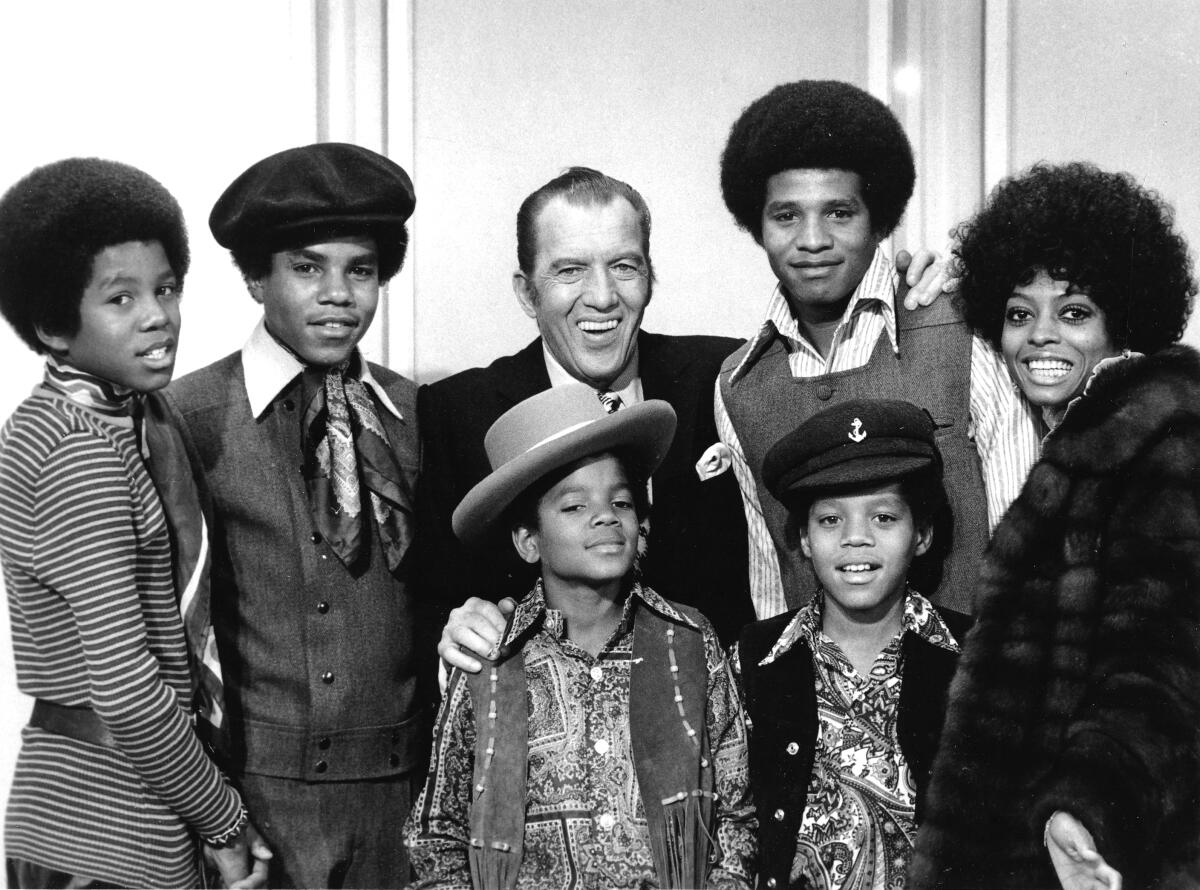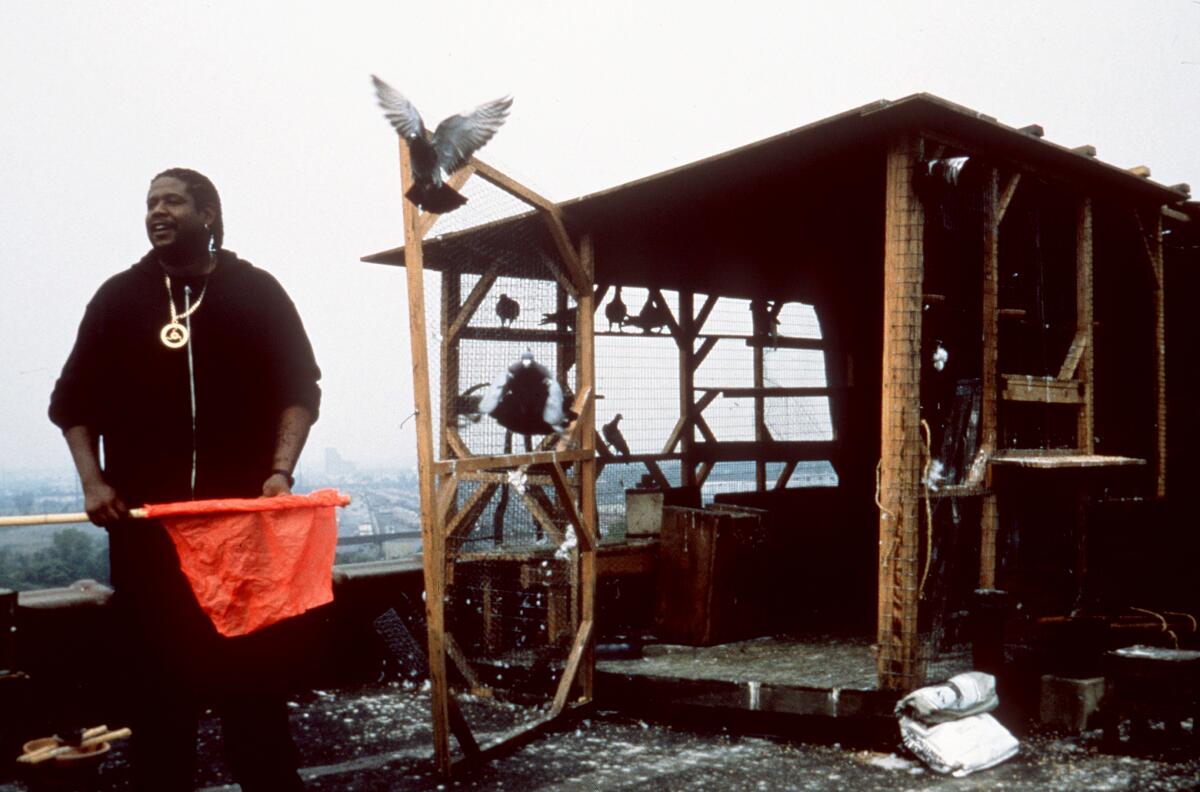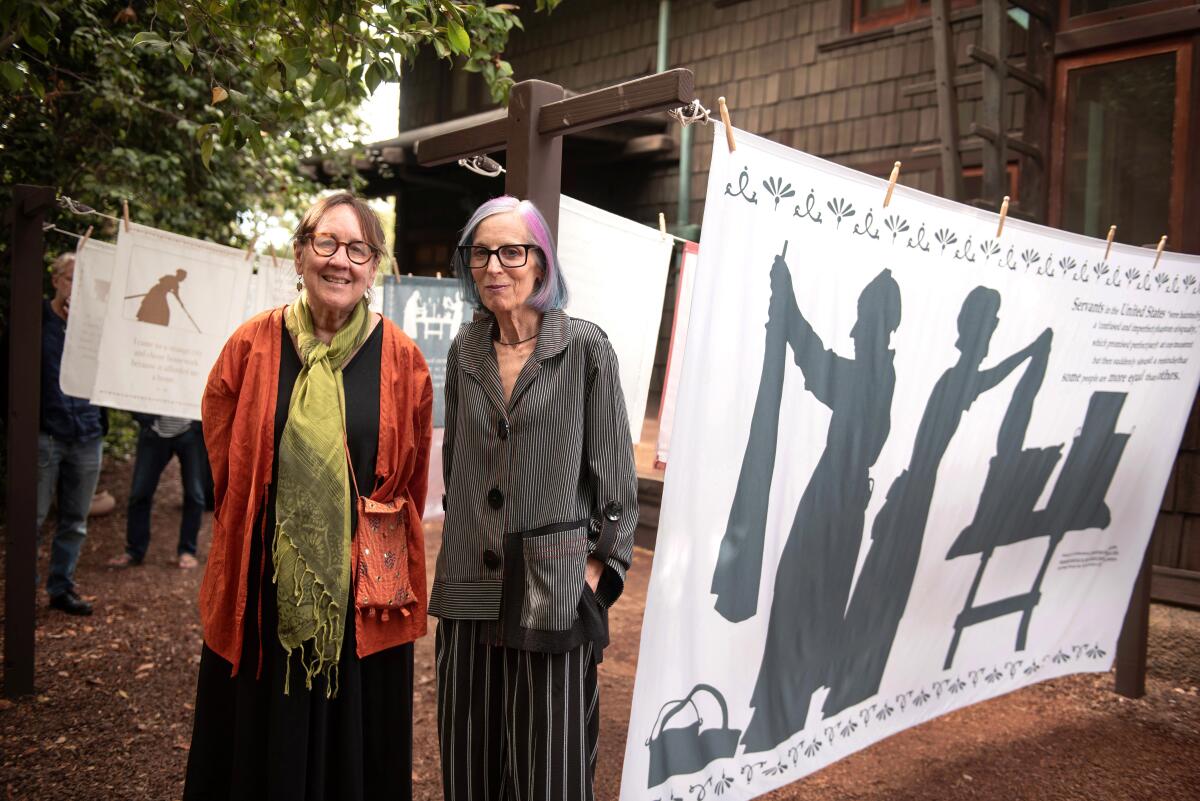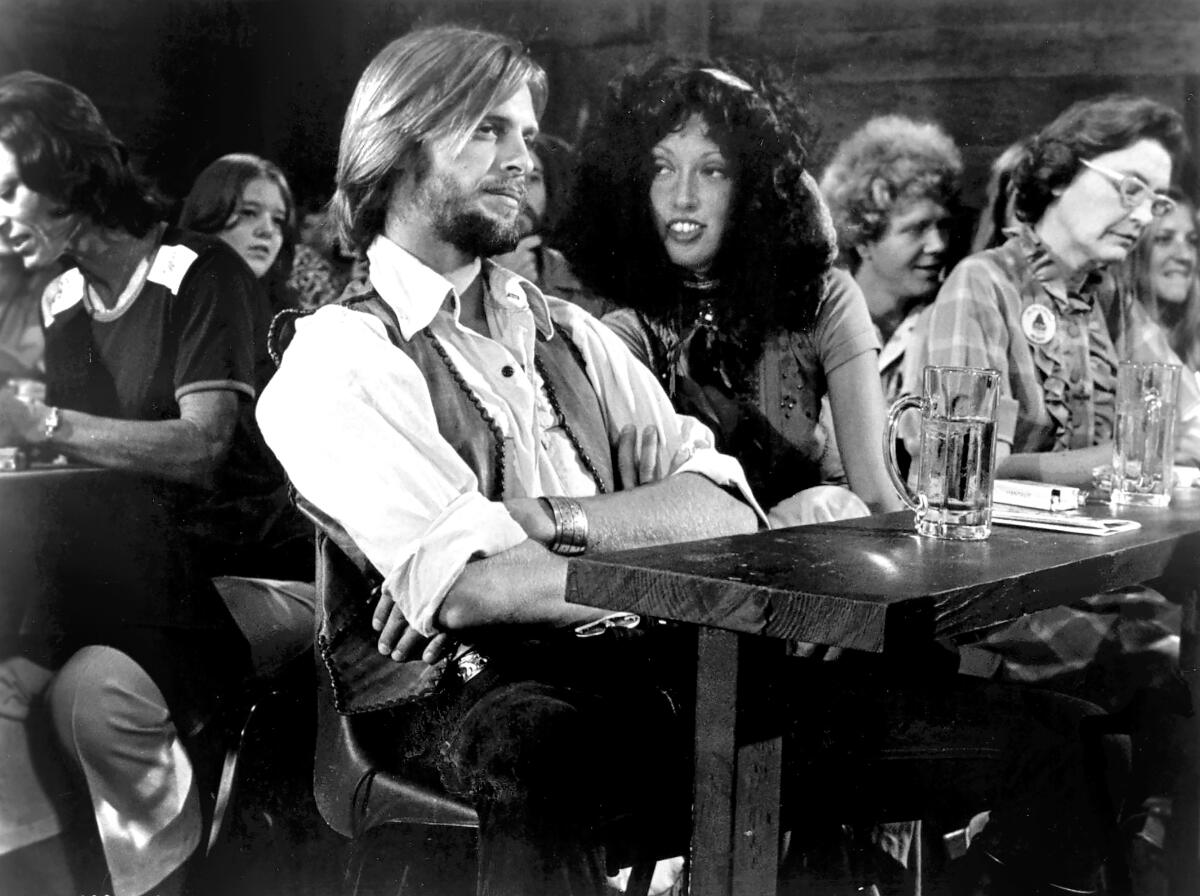Week in Pictures: From Russian missile attacks on Kyiv to floods in China
A roundup of major events last week.
Source link
A roundup of major events last week.
Source link
Matthew Stafford will apparently remain an observer for a while.
The Rams star quarterback, who has not practiced during training camp because of a back issue, will “probably not” practice Sunday in the final workout at Loyola Marymount, will not participate in Tuesday’s joint practice with the Dallas Cowboys, and his availability for a joint practice with the Chargers the following week will be determined, coach Sean McVay said.
Stafford, 37, saw back specialist Dr. Steven Watkins again on Saturday, McVay said.
McVay reiterated that Stafford was “week to week.”
“What I don’t want to do is set a timeline,” McVay said. “I know he’s making good progress. He saw Dr. Watkins again. … Everything is in good shape.”
Good shape?
McVay does not play starters in preseason games, so joint practices are regarded by the ninth-year coach as instrumental for evaluating young players and progress by the offense, defense and special teams.
Stafford, entering his 17th season, worked with new receiver Davante Adams during offseason workouts. But he has yet to work on timing with the three-time All-Pro during a full-speed, padded practice.
Veteran Jimmy Garoppolo continues to take first-team reps in Stafford’s place, and Stetson Bennett is directing the second-unit offense as the Rams prepare for their Sept. 7 opener against the Houston Texans at SoFi Stadium.
“Can’t wait to be able to get Matthew back out here leading the way,” McVay said, adding that Stafford felt the same way. “But in the meantime, Stetson and Jimmy are doing a really good job of continuing to get better and using these reps for their benefit.”
Stafford was one of several players who did not practice Saturday.
Rookie tight end Terrance Ferguson (groin) and defensive lineman Kobie Turner (back) sat out. Linebacker Nate Landman (calf) left practice as a precautionary measure, McVay said.
But Stafford’s continued absence from on-field drills continues to be the dominant storyline for a team that will be regarded as a legitimate Super Bowl contender if he is physically sound. And a question mark — at least on offense — if he is not.
After practicing with the Cowboys in Oxnard, the Rams and Cowboys will play Saturday at SoFi Stadium. The Rams play the Chargers at SoFi Stadium on Aug. 16, and they conclude the preseason on Aug. 23 against the Browns in Cleveland.
The Rams then have two weeks to prepare for the Texans.
Safety Quentin Lake intercepted another tipped pass. Safety Jaylen McCollough also intercepted a pass. … Tight end Colby Parkinson made a one-handed touchdown catch. … Bennett connected with rookie receiver Konata Mumpfield on several impressive pass plays. “He’s a mature rookie,” McVay said of Mumpfield. “He’s a guy that is wired to be able to separate. … He continues to be able to just answer the bell with the opportunities that he’s gotten.” … Former Rams defensive lineman Aaron Donald attended practice.
Welcome to Screen Gab, the newsletter for everyone who likes a dramatic comeback.
Remember when Heidi Klum drilled into our reality TV heads that, in fashion, one day you’re in, and the next day you’re out? Well, even she knows the past can come back in style. After a 16-season run on “Project Runway” as host and judge, Klum departed the fashion competition series in 2018 and, along with the show’s original mentor Tim Gunn, went on to create “Making the Cut,” their version of a fashion tournament for Prime Video that ran for three seasons. (Model Karlie Kloss assumed Klum’s “Project Runway” duties in subsequent seasons.) Now, as “Project Runway” launches its 21st season, moving homes yet again (to Freeform from Bravo), Klum brings the nostalgia factor to the show’s revamping, which includes the addition of super stylist Law Roach to the judges panel. Roach stopped by Guest Spot to discuss joining the ranks of the long-running reality competition.
Also in this week’s Screen Gab, our streaming recommendations include an illuminating documentary that explains how “The Ed Sullivan Show” amplified Black music and culture, and a collection of ‘90s films that defined an era through their soundtracks.
Must-read stories you might have missed

Luis Guzmán, Jenna Ortega and Catherine Zeta-Jones, photographed in London this month, return for the second season of Netflix’s “Wednesday.”
(Jennifer McCord / For The Times)
For Jenna Ortega, Catherine Zeta-Jones and Luis Guzmán, ‘Wednesday’ proves ‘weird is beautiful’: The actors return for Season 2 of Netflix’s hit YA series, which brings Gomez and Morticia Addams into focus.
‘Chief of War’ centers Hawaiian history and a warrior’s story: Co-creator Jason Momoa stars as the late 18th century warrior Ka’iana in a story set at the intersection of the Hawaiian island kingdoms and the arrival of European colonists.
Go behind the scenes with the ‘Alien: Earth’ cast at Comic-Con 2025: Watch our exclusive follow-along with the cast of FX’s “Alien: Earth” cast at San Diego Comic-Con as they sign autographs, visit the show’s immersive activation and more.
As AI changes how movies are made, Hollywood crews ask: What’s left for us?: AI is supplying powerful new tools at a fraction of the cost, forcing below-the-line artists to wonder if the future of filmmaking has a place for them.
Recommendations from the film and TV experts at The Times

Ed Sullivan with the Jackson 5 and Diana Ross.
(Netflix)
“Sunday Best: The Untold Story of Ed Sullivan” (Netflix)
Ed Sullivan was so famous, such an institution in his time, that his name became the text of a number in the musical “Bye Bye, Birdie.” It’s been half a century since “The Ed Sullivan Show” ended its 24-season run, but Sullivan, who gave Elvis Presley a platform and introduced the Beatles to America, will be seen as long as they continue to matter, which is to say, forever. The “Untold” in Sacha Jenkins’ affecting documentary is the show’s history with the many Black artists it presented to an audience of many millions, through years in which television networks bowed to the bigotry of what it called the Southern audience. Yet even had you taken Black acts on “Sullivan” for granted, the extent of the host’s progressivism might come as surprise. Those sharing memories include the late Harry Belafonte, Smokey Robinson and the Temptations’ Otis Williams; seen in performance are Stevie Wonder, Jackie Wilson, Bo Diddley, James Brown, Nina Simone, Mahalia Jackson and the Jackson 5, in all their youthful glory. — Robert Lloyd

Guided by the words of an ancient samurai text, Ghost Dog (Forest Whitaker) is a professional killer able to dissolve into the night and move through the city unnoticed in “Ghost Dog: The Way Of The Samurai.”
(Ghost Dog / Artisan Entertainment)
’90s Soundtrack Movies (Criterion Channel)
Now they exist as relics: banged-up soundtrack cassettes that slid around in the passenger side of everyone’s cars. But we all listened to them and in many cases, they ended up being more memorable than the films themselves. A lot of good was done when acts like U2, Talking Heads, Depeche Mode and Nick Cave lent their drawing power to director Wim Wenders’ mystifying 1991 sci-fi art thinker “Until the End of the World.” The songs were an adventure (though I couldn’t quote you a single line from the script). More substantially, Jim Jarmusch introduced his fan base to Wu-Tang Clan’s RZA, who contributed a superb head-bobbing soundtrack to 1999’s “Ghost Dog: The Way of the Samurai,” proving there was plenty of crossover between Soho and Shaolin. David Lynch, always plugged in musically, drew from David Bowie’s underrated “Outside” album for the white-line opening credits of 1997’s “Lost Highway.” And even when Bowie wasn’t game — as with the bio-in-all-but-name “Velvet Goldmine” — an inventive glam-saturated soundtrack could carry the day. Criterion’s new series is programming you can play in the background and still enjoy. — Joshua Rothkopf
A weekly chat with actors, writers, directors and more about what they’re working on — and what they’re watching

“Project Runway” adds Hollywood stylist Law Roach to its judges panel.
(Rankin / Disney)
As one of Hollywood’s biggest stylists and image architects, Law Roach has bolstered the fashion profile of stars like Zendaya, Hunter Schafer and Anya Taylor-Joy and set the tone for every red carpet he’s touched with his viral styling choices. Now, he’s bringing his unparalleled fashion sense to the judge’s panel of “Project Runway.” The new season premiered Thursday on Freeform with two episodes; it will air weekly and also stream on Hulu and Disney+. Roach stopped by Screen Gab to discuss his feelings on constructive criticism, the fictional character he’d like to style and what he’s watching. — Yvonne Villarreal
As a creative in the fashion world, is “Project Runway” a show you watched at any point over its run? What value did you see in it and how do you hope your involvement elevates the show?
Yes, I watched it religiously, of course. The season that Christian won is hands down still my favorite. I think it gave me an inside look at an industry that I was craving to be a part of. I think my real-world experience and passion will come through not only to the viewers but also to the contestants.
You bring a bold and direct feedback style to the judges panel from the start. How do you prefer to receive feedback on your work and when do you trust it?
Criticism is a part of every job. I think it is important to hear it and if it fits you or can help you grow, take it in, and learn from it, but if it doesn’t, ignore it.
As a stylist and image architect, which fictional character of TV or film — past or present — would you most like to create a fashion profile for?
Jessica Rabbit because we only got to see her in one look!
What’s your go-to “comfort watch,” the film or TV show you return to again and again?
“Top Chef” [Peacock] or any cooking competition show. I love food and witnessing the thought that goes into making the food.
Good morning, and welcome to L.A. on the Record — our City Hall newsletter. It’s Julia Wick, with an assist from David Zahniser, giving you the latest on city and county government.
Several millennia ago during the Trojan War, an army of Greeks built a massive wooden horse, feigned departure and left it as a “gift” outside the walled city of Troy.
The Trojans brought the offering — filled, unbeknownst to them, with Greek soldiers — into their fortified city and unwittingly wrought their own downfall. At least that’s how the legend goes.
Newsletter
You’re reading the L.A. on the Record newsletter
Sign up to make sense of the often unexplained world of L.A. politics.
You may occasionally receive promotional content from the Los Angeles Times.
So if an attack disguised as a gift is a Trojan horse, what do you call a gift disguised as an attack?
One could argue that the attempted recall of Mayor Karen Bass inadvertently fits the bill.
Back in early March, Silicon Valley philanthropist and former Robert F. Kennedy Jr. running mate Nicole Shanahan launched an effort to recall Bass. At the time, Bass was still on her back foot — an incumbent, first-term mayor who’d become a national target for her initial response to the Palisades fire.
It’s notoriously difficult to gather enough signatures to trigger a recall. But Shanahan’s extremely deep pockets (her ex-husband co-founded Google) made anything possible. With the mayor already wounded and Angelenos feeling angry and frustrated, a well-funded recall effort could have been the spark that torched Bass’ reelection chances.
That did not come to pass.
Proponents didn’t even finish the paperwork necessary to begin gathering signatures, then tweeted in June that a recall would “no longer be our vehicle for change” and that they would instead focus on holding elected officials accountable at the ballot box in 2026. Their spokesperson has not responded to several emails from The Times.
But the short-lived recall effort had one effect its proponents likely did not anticipate. During a tenuous moment for Bass, they may have unintentionally handed her an extremely useful tool: the ability to form an opposition committee unencumbered by limits on the size of the donations she collects.
The threat from Shanahan’s group allowed Bass to form her own anti-recall campaign committee — separate from her general reelection account, which cannot collect more than $1,800 from each donor. Now, she could raise more money from her existing supporters, in far larger amounts.
Flash forward to this week, when the latest tranche of campaign finance numbers were released, revealing how much was raised and spent from the beginning of the year through the end of June. While Bass’ official reelection campaign took in an anemic $179,589, her anti-recall coffers hoovered up more than four times that amount.
The nearly $750,000 collected by the anti-recall campaign included two major donations at the end of March that we previously reported on: $250,000 from the Bass-affiliated Sea Change PAC and $200,000 from former assembly speaker and Actum managing partner Fabian Núñez’s leftover campaign cash.
Along with Núñez and Sea Change, the largest donors were philanthropists Jon Croel and William Resnick ($25,000 each), businessman Baron Farwell ($25,000) and former City Councilmember Cindy Miscikowski ($15,000). Several others gave $10,000 a piece, including pomegranate billionaire and power donor Lynda Resnick.
It’s far easier to rally donations when you’re dealing with an impending threat. (“Save the mayor from a right-wing recall!” is much catchier than asking for reelection dollars when a serious challenger has yet to jump into the race.) And it’s infinitely faster to stockpile cash when you aren’t limited to $1,800 increments.
“After the fires and what had happened, anything was possible, and we had to mobilize, and that’s what the mayor did,” said Bass campaign strategist Doug Herman. “But the people of the city didn’t want to have a recall in the midst of what they thought were more serious problems.”
Shanahan declined to comment.
When the recall effort officially times out on Aug. 4, the Bass camp will no longer be able to raise unlimited sums to fight it (with a few exceptions, such as expenses related to winding down the committee or settling debt). But the anti-recall committee will still have quite the extra arsenal to fire off in her favor.
Sometimes your loudest enemies are really friends in disguise.
—WHITHER CARUSO? Brentwood resident and former Vice President Kamala Harris announced this week that she would not be running for governor, intensifying questions about whether former mayoral candidate Rick Caruso might jump into the gubernatorial race … or potentially challenge Bass again for mayor. Through a spokesperson, Caruso declined to comment.
— RACE FOR THE 8TH FLOOR: City Attorney candidate Marissa Roy outraised incumbent Hydee Feldstein Soto during the latest fundraising period, delivering a major warning shot about the seriousness of her campaign. For now, Feldstein Soto still has more cash on hand than Roy, who is challenging her from the left.
— COASTAL CASH: In the race for a Westside council district, public interest lawyer Faizah Malik raised a hefty $127,360, but her stash pales in comparison to the $343,020 that incumbent Councilmember Traci Park brought in during the most recent filing period. That’s far more than any other city candidate running in the June 2026 election.
— AHEAD OF THE PACK: Council staffer Jose Ugarte, who’s hoping to succeed his boss, termed out Councilmember Curren Price, in a crowded South L.A. race, raised a whopping $211,206, far outpacing his rivals.
— VIEW FROM THE VALLEY: During this filing cycle, Tim Gaspar and Barri Worth Girvan both brought in real money in the race to succeed outgoing Councilmember Bob Blumenfield in the West Valley. Girvan outraised Gaspar during the past half-year, but Gaspar entered the race earlier and still has substantially more cash on hand.
— WHERE’S MONICA? One incumbent who didn’t report any fundraising is Valley Councilmember Monica Rodriguez. When reached Friday, Rodriguez said she is still planning to run for reelection and was in the process of changing treasurers. She did not answer when asked whether she was also considering a potential mayoral bid, as has been rumored.
— WHAT ABOUT KENNETH? City Controller Kenneth Mejia does not have any campaign finance numbers listed because he qualified his reelection committee after the June 30 fundraising deadline. He’ll be required to share fundraising numbers for the next filing period.
— LOWER LAYOFFS: The number of employee layoffs planned for the 2025-26 fiscal year continued to decline this week, falling to 394, according to a report released Friday by City Administrative Officer Matt Szabo. Bass’ budget had proposed 1,600 earlier this year. Szabo attributed much of the decrease to the transfer of employees to vacant positions that are not targeted for layoff.
— TOKENS OF APPRECIATION: According to her disclosure forms, Bass’ reelection committee spent more than $1,100 on gifts “of appreciation,” including flowers sent to Mayer Brown lawyers Edgar Khalatian, Dario Frommer and Phil Recht; Fabian Núñez; lawyer Byron McLain; longtime supporters Wendy and Barry Meyer; author Gil Robertson; former Amazon exec Latasha Gillespie; L.A. Labor Fed head honcho Yvonne Wheeler; lobbyist Arnie Berghoff; Faye Geyen; and LA Women’s Collective co-founder Hannah Linkenhoker. The most expensive bouquet ($163.17, from Ode à la Rose) went to Lynda Resnick.
— PIZZA INTEL: Bass has not, to my knowledge, publicly shared the names of her reelection finance committee. But her forms list a $198.37 charge at Triple Beam Pizza for food for a “finance committee meeting” with Cathy Unger, Victoria Moran, Ron Stone, Kellie Hawkins, Todd Hawkins, Cookie Parker, Stephanie Graves, Leslie Gilbert-Lurie, George Pla, Wendy Greuel, Byron McLain, Chris Pak, Travis Kiyota, Areva Martin and Kevin Pickett. Bass’ consultant did not immediately respond when asked if that list constituted her finance committee, and if anyone was missing.
— FAMILY-FRIENDLY PROGRAMMING? Speakers at Los Angeles City Council meetings will be banned from using the N-word and the C-word, the council decided Wednesday. But my colleague Noah Goldberg reports that the council’s decision to ban the words could be challenged in court, with some legal scholars saying it could violate speakers’ 1st Amendment free speech rights to curse out their elected officials.
— ZINE O’ THE TIMES: City Councilmember Bob Blumenfield finally named his pick for the city’s Charter Reform Commission: Dennis Zine, who served on the council for 12 years, representing the same West Valley district as Blumenfield. Zine spent more than three decades as an officer with the LAPD while also serving on the board of the Police Protective League, the union that represents rank-and-file officers, and should not be confused with progressive former Santa Monica mayor Denny Zane.
That’s it for this week! Send your questions, comments and gossip to [email protected]. Did a friend forward you this email? Sign up here to get it in your inbox every Saturday morning.
Through the glassed-in entrance of Citizen Public Market in Culver City, up its short flight of stairs, past scents of barbecue coming from the Smokey Chance stand and chefs wrapping dry-aged fish into handrolls at Uoichiba, I turn a sharp right and reach the back of the food hall. Kiano Moju stands at an island behind an L-shaped counter. She’s calling out orders: “Two chicken and a beef, please. And I’m still waiting on a shrimp?”
Moju is the author of “AfriCali,” one of the Food team’s favorite cookbooks of 2024, in which she grafts the East African and West African flavors of her heritage with an approach to cooking she learned growing up in the Bay Area. In her hands, bacon, avocado and tomato jam fill an omelet rolled into a chapati in the Ugandan street food called rolex, and dirty chai (jolted with a shot of espresso) complicates the classic charms of tiramisu.
Now Moju has given herself a new job title: restaurateur.
Jikoni, which means “kitchen” in Swahili, is the name of her pop-up operating inside the market from Wednesday to Sunday throughout summer. Dishes derive from recipes in “AfriCali.” She’s structured the menu around riffs on street-food kebabs she remembers from coastal Kenya, where she spent summers growing up.
In the book she writes, “My first time eating mishkaki was in the northern part of Mombasa, in a local eatery where the meat hits your table within seconds of it being pulled off the charcoal grill. The accompaniments are simple because the meat is the star.”

A crowd gathers to order at Jikoni, Kiano Moju’s summertime pop-up inside Citizen Public Market in Culver City.
(Bill Addison / Los Angeles Times)
As one example of her adaptive process: In “AfriCali,” she considers how to rework chicken and chips, a fast food popular in Nairobi that pairs flash-fried chicken and fries with poussin sauce made of chile-spiced butter and lemon juice. For the cookbook version, she rubs chicken with garlic and dried oregano before roasting it and then brushing the bird with poussin sauce right before serving.
At Jikoni, she grills chicken thighs threaded on skewers. The buttery sauce brings the character, with smoked paprika and Kashmiri chile powder (which has its own berry-like smokiness), a base of ginger and garlic and lemon juice’s lifting tartness. Similarly, garlicky butterflied shrimp soak in peri-peri butter, fragrant with basil, parsley and cilantro and punched with sweet paprika and cayenne pepper.
“Suya” is a Nigerian word for skewers typically coated with yaji, a peppery spice blend that includes crushed peanuts and burns with cayenne and cardamom. Moju thoroughly coats lamb chops with yaji and rosemary; the meat can stand up to the barrage.

A mix of mishkaki (skewered meats) and sides at Jikoni in Citizen Public Market, including egusi and kale in the center.
(Bill Addison / Los Angeles Times)
Each mishkaki variation comes with two sides. Among them: Moju’s simplified variation on egusi, the Nigerian stew thickened with ground melon seeds, which she renders far less soupy paired with kale. She seasons the dish with curry powder and, crucially, ground crayfish for its specific umami. A soothing recipe in “AfriCali” for chickpeas simmered in coconut sauce here becomes a foil for butter beans: They half-melt into coconut milk curried with garam masala and cumin seeds and tinted with turmeric.
Those are my two favorites, though I’d also encourage an extra side of basmati rice to sop up a meal’s mingled sauces. And then dessert: a riff on Key lime pie with the addition of fresh passion fruit and gingersnaps for the crust.
Jikoni is a thoroughly heartening endeavor. Minus our wealth of Ethiopian restaurants, Los Angeles has too few showcases for the cuisines of Africa; how rich to have a glimpse into contrasting tastes of two of the continent’s coastal cultures on one succinct menu. And given the far more common path of chef to cookbook author, it’s fun to see how Moju and her crew (which frequently includes her mother, Katano Kasaine) acclimate her recipes to the rhythms of restaurant-style service. Interior design is also among her talents: Notice the beautifully curated shelves behind the ordering counter, arranged with African pottery and art and cookbooks written on a breadth of cuisines across Africa and its diasporas, that brings to mind the dining room of Two Hommés in Inglewood that she helped reenvision.

Kiano Moju pictured in the Los Angeles Times test kitchen, preparing pumpkin chapati for an episode of “Chef That!”
(Robert Hanashiro / For The Times)
In June, as a practice run for Jikoni, Moju settled into the market stand by serving Swahili-style biriyani, a Kenyan variation in which rice and saucy spiced meat (short ribs, in this case) are cooked separately and combined on the plate with fried onions and rounds of green chile. I heard glowing reports about the biriyani but missed its early run.
Good news: Many people have asked for it, so Moju has said she’ll be re-creating the dish as a recurring Sunday night special. See you there.
Jikoni at Citizen Public Market, 9355 Culver Blvd., Culver City, jikoni.co
Newsletter
You’re reading Tasting Notes
Our L.A. Times restaurant experts share insights and off-the-cuff takes on where they’re eating right now.
You may occasionally receive promotional content from the Los Angeles Times.

Phyllis Harris with two granddaughters at a dim sum restaurant in Los Angeles.
(Jenn Harris / Los Angeles Times )
Newsletter
Eat your way across L.A.
Like what you’re reading? Sign up to get it in your inbox every week.
You may occasionally receive promotional content from the Los Angeles Times.

University of California leaders face a difficult choice after the U.S. Department of Justice said this week that UCLA had violated the civil rights of Jewish students during pro-Palestinian protests and federal agencies on Wednesday suspended more than $300 million in research grants to the school.
Do they agree to a costly settlement, potentially incurring the anger of taxpayers, politicians and campus communities in a deep-blue state that’s largely opposed to President Trump and his battle to remake higher education?
Or do they go to court, entering a protracted legal fight and possibly inviting further debilitating federal actions against the nation’s premier public university system, which has until now carefully avoided head-on conflicts with the White House?
Leaders of the University of California, including its systemwide president, James B. Milliken; UCLA Chancellor Julio Frenk and UC’s 24-member Board of Regents — California Gov. Gavin Newsom is an ex-officio member — have just days to decide.
In findings issued Tuesday, U.S. Atty. Gen. Pam Bondi and the Justice Department said UCLA would pay a “heavy price” for acting with “deliberate indifference” to the civil rights of Jewish and Israeli students who complained of antisemitic incidents since Oct. 7, 2023. That’s when Hamas attacked Israel, which led to Israel’s war in Gaza and the pro-Palestinian student encampment on Royce Quad.
The Justice Department gave UC — which oversees federal legal matters for UCLA and nine other campuses — a week to respond to the allegations of antisemitism. It wrote that “unless there is reasonable certainty that we can reach an agreement” to “ensure that the hostile environment is eliminated and reasonable steps are taken to prevent its recurrence,” the department would sue by Sept. 2.
A day after the Justice Department disclosed its findings, the National Institutes of Health, National Science Foundation, Department of Energy and other federal agencies said they were suspending hundreds of grants to UCLA researchers. A letter from the NSF cited the university’s alleged “discrimination” in admissions and failure to “promote a research environment free of antisemitism.” A Department of Energy letter cutting off grants on clean energy and nuclear power plants made similar accusations, adding that “UCLA discriminates against and endangers women by allowing men in women’s sports and private women-only spaces.”
Initial data shared with The Times on Thursday night showed the cuts to be at least $200 million. On Friday, additional information shared by UC and federal officials pointed to the number being greater than $300 million — more than a quarter of UCLA’s $1.1 billion in annual federal funding and contracts. UCLA has not released a total number.
In a campuswide message Thursday, Frenk, the UCLA chancellor, called the government’s moves “deeply disappointing.”
“This far-reaching penalty of defunding life-saving research does nothing to address any alleged discrimination,” Frenk said.
In a statement to The Times Friday, an official from the Department of Health and Human Services, which oversees the NIH, said it would “not fund institutions that promote antisemitism. We will use every tool we have to ensure institutions follow the law.”
An NSF spokesperson also confirmed the UCLA cuts, saying Friday that the university is no longer in “alignment with current NSF priorities.” A Department of Energy spokesperson also verified the cuts but did not elaborate outside of pointing to the department’s letter to UCLA.
The Times spoke to more than a dozen current and former senior UC leaders in addition to higher education experts about the rapid deliberations taking place this week, which for the first time have drawn a major public university system into the orbit of a White House that has largely focused its ire on Ivy League schools.
Trump has accused universities of being too liberal, illegally recruiting for diversity in ways that hurt white and Asian American students and faculty, and being overly tolerant of pro-Palestinian students who he labels as antisemites aligned with Hamas.
Universities, including UCLA, have largely denied the accusations, although school officials have admitted that they under-delivered in responding to Jewish student concerns. In the last two years, encampments took over small portions of campuses, and, as a result, were blamed for denying campus access to pro-Israel Jews.
In a major payout announced Tuesday — before the Justice Department’s findings — UCLA said it would dole out $6.45 million to settle a federal lawsuit brought by three Jewish students and a medical school professor who alleged the university violated their civil rights and enabled antisemitism during the pro-Palestinian encampment in 2024. About $2.3 million will be donated to eight groups that work with Jewish communities, including the Anti-Defamation League, Chabad and Hillel. Another $320,000 will be directed to a UCLA initiative to combat antisemitism, and the rest of the funds will go toward legal fees.
Through spokespersons, Frenk and Milliken declined interviews on what next steps UCLA might take. Friday was Milliken’s first day on the job after the long-planned departure of former UC President Michael V. Drake, who will return to teaching and research.
But in public remarks this week, Newsom said he was “reviewing” the Justice Department’s findings and that UC would be “responsive.”
The governor, who spoke during an event at the former McClellan Air Force Base in Sacramento County on Thursday, said he had a meeting with Drake scheduled that day to discuss the Trump administration’s charges.
Newsom did not respond specifically to a question from The Times about whether UC would settle with Trump.
“We’re reviewing the details of the DOJ’s latest and then that deadline on Tuesday,” the governor said. “So we’ll be responsive.”
In a statement Friday, Newsom said, “Freezing critical research funding for UCLA — dollars that were going to study invasive diseases, cure cancer, and build new defense technologies — makes our country less safe. It is a cruel manipulation to use Jewish students’ real concerns about antisemitism on campus as an excuse to cut millions of dollars in grants that were being used to make all Americans safer and healthier.”
Senior UCLA and UC leaders, who spoke on background because they were not authorized to discuss legal decisions, said the university has been bracing for this moment for months. The university and individual campuses are under multiple federal investigations into alleged use of race in admissions, employment discrimination against Jews, and civil rights complaints from Jewish students. At the same time, leaders said, they were hoping the multimillion-dollar settlement with Jewish students would buy them time.
“It backfired,” said one senior administrator at UCLA, reflecting the sense of whiplash felt among many who were interviewed. “Within hours of announcing our settlement, the DOJ was on our back.”
Other senior UC officials said the system was considering suing Trump. It has already sued various federal agencies or filed briefs in support of lawsuits over widespread grant cuts affecting all major U.S. universities. UC itself, however, has not directly challenged the president’s platform of aggressively punishing elite schools for alleged discrimination.
It’s unclear if a suit or settlement could wipe out all remaining investigations.
Mark Yudof, a former UC president who led the system from 2008 to 2013, said he felt the Trump administration was targeting a public university as a way to “make a statement” about the president’s higher education aims going beyond Ivy League institutions.
“But this is not Columbia,” Yudof said, referring to the $221-million settlement the New York campus recently reached with the White House to resolve investigations over alleged antisemitism amid its response to pro-Palestinian protests.
On Wednesday, Brown University also came to a $50-million agreement with the White House. The Brown payment will go toward Rhode Island workforce development programs. Harvard is also negotiating a deal with the government over similar accusations regarding antisemitism.
“The University of California is much more complex,” said Yudof, who lives in Florida and also led the University of Texas and University of Minnesota. “For one, an issue that may affect UCLA is not going to affect UC Merced or UC Riverside. But do you come to an agreement on all campuses? If there is a settlement payment, does it affect all campuses, depending on the cost?”
George Blumenthal, a former chancellor of UC Santa Cruz, said he “just can’t see UC making the kind of deal that Columbia did or that Harvard contemplates. Committing public funds to Washington to the tune of tens or hundreds of million dollars strikes me as politically untenable in California.”
Pro-Palestinian UCLA groups said they don’t agree with the premise of negotiations. They point out that many protesters in last year’s encampment were Jewish and argue that the protest — the focus of federal complaints — was not antisemitic.
“We reject this cynical weaponization of antisemitism, and the misinformation campaign spinning calls for Palestinian freedom as antisemitic. We must name this for what it is: a thinly-veiled attempt to punish supporters of Palestinian freedom, and to advance the long-standing conservative goal of dismantling higher education,” said a statement from Graeme Blair, a UCLA associate professor of political science, on behalf of UCLA Faculty for Justice in Palestine.
Higher education experts say UC’s decision would set a national precedent. The university’s finances include more than $50 billion in operating revenues, $180 billion in investments — including endowment, retirement, and working capital portfolios — and smaller campus-level endowments. The funds support facilities across the state, including multiple academic health centers, investment properties and campuses, as well as tens of thousands of former employees enrolled in retirement plans.
Dozens of public campuses across the U.S. are under investigation or pressure from the White House to atone for alleged wrongdoing to Jewish students or to change admissions, scholarship programs and protest rules and more. But UC has long been a standard-bearer, including in academic and protest freedoms.
“If you are Trump, your target of Harvard or Brown is much easier — a snooty elite — than a public, even a UCLA or Berkeley,” said Rick Hess, an education expert with the conservative American Enterprise Institute.
Kenneth Marcus, who served as assistant secretary for civil rights in the Education Department during Trump’s first term, said there would be benefits for UCLA and the UC system to enter into a “systemwide agreement that would enable everybody to put this behind themselves.”
The Justice Department’s Tuesday letter said it was investigating all campuses but only issuing findings of violations so far at UCLA.
Marcus, chairman of the Washington, D.C.-based Louis D. Brandeis Center for Human Rights Under Law, said a systemwide agreement would “provide the federal government with assurances that the regents are making changes across the board.”
Staff writer Taryn Luna in Sacramento contributed to this report.
TAMPA, Fla. — The Dodgers didn’t go shopping at the top of the market ahead of Thursday’s trade deadline.
But what they came away with — right-handed relievers Brock Stewart and Paul Gervase to bolster the bullpen, and versatile outfielder Alex Call to round out the lineup — are the kind of moves that “just raises the floor for our ballclub,” manager Dave Roberts said Friday.
“I feel we did get better,” Roberts said, before echoing the front office’s hope that the Dodgers’ biggest improvements over the final two months of the season come from the star-studded, but underperforming, core they already have in place.
“I think we’ve got a pretty dang good team. I think if you look at it from the offensive side, as far as our guys, they’ll be the first to tell you they’ve got to perform better and more consistently. That’s something that we’re all counting on … I love our club. I really do. Now it’s up to all of us to go out there and do our jobs.”
The job for the Dodgers’ two biggest acquisitions, Stewart and Call, will be clear from the get-go.
Stewart, a former Dodgers swingman from 2016 to 2019, has reinvented himself in the second half of his career. Unlike his first stint in Los Angeles, when he threw in the low 90s and was a fringe long reliever on the roster, Stewart is now a higher-leverage relief option, with a mid-to-upper 90s fastball and swing-and-miss sweeper he has used to dominate right-handed hitters this season.
“At the end [of his first Dodgers stint], he lost the velocity and was trying to figure out if he could hang on and who he was at that point,” Roberts recalled. “Obviously, he’s put in a ton of work to sort of find himself again. He’s had nothing but success. I’m excited to see this version of him. He certainly shouldn’t lack for confidence.”
Stewart won’t fix the Dodgers’ ninth-inning problems — with their closer role up in the air ever since struggling offseason signing Tanner Scott went on the injured list with an elbow injury — but could get some save situations “in the right situation,” Roberts said — for instance, if a run of right-handed hitters (who are batting just .104 with a .327. OPS against him this year) are up at the end of the game.
“I trust the guy, I trust the player, what he’s become,” Roberts said. “So for me, if the situation calls for it tonight and he’s in the ninth inning, I’ve got all the confidence.”
Gervase, a 6-foot-10 right-hander the Dodgers acquired from the Tampa Bay Rays in exchange for catcher Hunter Feduccia as part of a three-team trade on Wednesday night, was also on the active roster Friday. He comes with just five previous career MLB appearances, but a deceptive delivery aided by his long-limbed extension on the mound.
“I don’t know a whole lot about him,” Roberts said. “I know he’s got a big arm. He’s got some extension, some rise, but I haven’t seen him.”
The arrival of Stewart and Gervase did coincide with yet another loss in the bullpen. Veteran right-hander Kirby Yates, another offseason signing who has disappointed with a 4.31 ERA this season, was placed on the injured list because of lingering discomfort in his pelvic and lower-back area. He went back to Los Angeles to get further testing.
“In the last, call it, two weeks, he hasn’t felt great,” Roberts said. “Hasn’t been injured, in his words, which is why he kept pitching and competing. But we flew him home this morning to look at the doctor and kind of get some tests to see if there’s something that’s kind of been aggravating him. Something’s just not right, exactly. So we’re trying to suss that out.”
In the lineup, Roberts said Call — a 30-year-old right-handed-hitting journeyman who found a niche with the Washington Nationals the last few seasons as an on-base threat capable of grinding out tough at-bats — would mix in at all three outfield spots.
“[He is] a tough, feisty hitter,” Roberts said. “I certainly see him playing versus left. But I think he’s pretty much a neutral guy. Slugs a little more against left, but gets on base against right. I’m going to try to keep him in there a couple times a week.”
Call said he wasn’t shocked to learn he had been traded on Thursday, and was excited by the “chance to compete in the playoffs and win a World Series” with a first-place Dodgers team.
“For me, I am going to grind out at-bats, put the ball in play, take my walks, make it tough on the pitcher,” said Call, who has hit .297 with the Nationals in 102 games over the last two seasons. “Just really make the [pitchers] work so that hopefully they’re tired when the top of the order comes back around or whatever.”
Internally, the Dodgers are hoping rookie Japanese pitcher Roki Sasaki can also serve as a de facto late-season addition after missing the last several months with a shoulder injury.
And this week, the right-hander took a key step in his recovery process.
Sasaki faced hitters for the first time since getting hurt in a simulated inning this past week in Arizona, Roberts said, and is scheduled to throw two more simulated innings on Saturday.
The team has been targeting a late-August return for Sasaki, who had a 4.72 ERA in eight starts this season before going on the IL.
When looking at a majestic residence like the 1908 Gamble House — a Craftsman crown jewel of Pasadena — its easy to romanticize the lives of its owners. Luxury and wealth radiate from its graceful, low-slung eaves, sloping lawns and wide porches. But the idea of class is baked into its architecture, with a series of rooms built to be occupied by the domestic servants who toiled day and night to keep the house running for its privileged inhabitants, the heirs to the Proctor & Gamble fortune.
Through Aug. 17, those rooms are open for tours with the addition of a compelling art installation by Karen Schwenkmeyer and Lisa Mann titled “Dirty Laundry,” which examines the heartache, disappointments and perseverance of domestic laborers in the early 20th century by printing their words on tea towels and sheets hung in the Gamble House’s drying yard, and stitching them into a pillowcase in one of the small staff bedrooms.
“What I mind is the awful loneliness,” reads the pillowcase on austere wooden twin bed. “Many times, many nights I went to bed and cried myself sick.”
A sculpture constructed of Ivory soap, mops and scrub brushes takes up residence in the staff bathroom. The soap, one of Procter & Gamble’s bestselling products, was marketed as 99.44% pure, and the sculpture is a meditation on “who is pure and who is not,” explained Mann during an opening reception for the installation, adding that she and Schwenkmeyer approached the lavatory as “a place of resistance and empowerment.”
The goal of the installation, say Schwenkmeyer and Mann, was to bring to light the “emotional and psychological toll of being on-call every day of the week.”
A tea towel blowing in the warm Southern California air puts it more plainly: “I hope someday will come when I don’t have to work so hard … I do hate to get up in the morning. I am so tired.”

Artists Karen Schwenkmeyer and Lisa Mann stand with their installation “Dirty Laundry” at the Gamble House in Pasadena.
(Paul Takizawa)
Domestic staff in many of the country’s most rarefied households was made up of immigrants who came to America looking for a better life only to find themselves stuck in the same classist , low-wage systems they had fled in the first place, the artists explan.
“Servants in the United States ‘were haunted by a confused and imperfect phantom of equality,’ which promised perfect parity at one moment but then suddenly shouted a reminder that some people are more equal than others,” reads a bedsheet quoting from a book about Americans and their servants by Daniel E. Sutherland, which greets visitors upon entrance to the yard.
Thinking of these words and imagining the lives of the many men, women and children who devoted their lives to caring for wealthy people is a potent way to walk through the beautiful rooms inside the Gamble House. We may not call domestic laborers servants anymore, but the way we choose to treat those who tend to our many needs — to see them and respect them, or not — speaks volumes of who we are as a society.
I’m arts and culture writer Jessica Gelt, rethinking all my assumptions about a bar of soap. Here’s this weeks art news.
Newsletter
You’re reading Essential Arts
Our critics and reporters guide you through events and happenings of L.A.
You may occasionally receive promotional content from the Los Angeles Times.

The Broadway cast of the musical comedy “Some Like it Hot” in 2022. The national tour is now playing at the Hollywood Pantages.
(Courtesy of Marc J. Franklin)
Some Like It Hot
This musical adaptation of Billy Wilder’s 1959 film comedy about two musicians who go on the run disguised as women after witnessing a mob hit in prohibition-era Chicago brings a contemporary sensibility to the 1930s shenanigans. The Broadway production won four Tony Awards in 2023.
Through Aug. 17. Hollywood Pantages Theatre, 6233 Hollywood Blvd., Hollywood. broadwayinhollywood.com

Keith Carradine and Shelly Duvall in Robert Altman’s “Nashville.”
(Paramount Pictures)
Robert Altman’s America: A Centennial Review
UCLA Film and Television Archive celebrates the late filmmaker’s 100th birthday with a 13-film series that kicks off with 1976’s “Nashville,” which melds politics with country music and features a large ensemble including Ned Beatty, Karen Black, Ronee Blakley, Keith Carradine, Geraldine Chaplin, Shelley Duvall, Barbara Harris, Lily Tomlin and dozens more.
7:30 p.m. Friday; series continues through Sept. 26. Billy Wilder Theater, UCLA Hammer Museum, 10899 Wilshire Blvd., Westwood. cinema.ucla.edu

Musician Adrian Quesada performs a free concert, co-hosted by De Los, on Saturday.
(James Carbone/For De Los)
Adrian Quesada
De Los, The Times’ platform for all things Latinidad, co-hosts a free concert by the Grammy-winning musician and Oscar-nominated songwriter. Best known for his work in the bands Grupo Fantasma and Black Pumas, Quesada’s latest album, “Boleros Psicodélicos II,” is “a 12-track sonic field trip through Quesada’s Latin American influences — and a testament to teamwork,” wrote Carlos De Loera in a recent De Los profile.
6 p.m. Saturday. Grand Performances, 350 S. Grand Ave., downtown L.A. grandperformances.org

The Actors’ Gang’s performance of “Roswell That Ends Well.”
(Bob Turton Photography)
Roswell That Ends Well
The Actors’ Gang turns the Bard on his ear in this year’s Shakespeare in the Park production, an adaptation of “All’s Well That Ends Well” where outer space meets the Wild West in the form of a determined cowgirl with big dreams and a four-armed alien king.
11 a.m. Saturdays and Sundays, through Aug. 24. Admission is free, reservations highly suggested. Media Park, 9070 W. Venice Blvd., Culver City. theactorsgang.com

Chow Yun-Fat in John Woo’s “A Better Tomorrow.”
(Shout! Studios)
Hong Kong Cinema Classics
The American Cinematheque and Beyond Fest, in partnership with Shout! Studios and GKIDS, present a retrospective of seminal films, many of which are rarely screened. Genre master John Woo will appear with his films “Hard Boiled” (7 p.m. Saturday), a triple feature of the “A Better Tomorrow” trilogy (11 a.m. Sunday) and “The Killer” (7 p.m. Sunday). The monthlong series also includes films by stalwart action directors Tsui Hark, Ringo Lam and Ching Siu-tung.
7 p.m. Saturday; 11 a.m. Sunday; 7 p.m. Sunday. Egyptian Theatre, 6712 Hollywood Blvd. americancinematheque.com

Karl Benjamin, #13, 1970. Oil on canvas, 68” x 68”
(Gerard Vuilleumier)
Complications in Color
A new exhibition marks the 100th birthday of Claremont artist Karl Benjamin (1925-2012), a painter and leader in the 1950s hard-edge abstraction painting movement. In his review of the 2007 survey of the painter’s work, Times art critic Christopher Knight wrote, “Benjamin emerges as a colorist of great wit and inventiveness.” The current exhibition also features the work of fellow abstractionists Florence Arnold, June Harwood, Rachel Lachowicz and Terry O’Shea.
Noon-4 p.m. Thursdays and Saturdays; noon-7 p.m. Fridays; 10 a.m.-4 p.m. Sundays, through Nov. 16. Claremont Lewis Museum of Art, 200 W. First St., Claremont. clmoa.org

Gustavo Dudamel is back at the Hollywood Bowl on Tuesday and Thursday.
(Jason Armond / Los Angeles Times)
Gustavo Dudamel returns
The maestro is back at the Bowl next week and makes the most of it. On Tuesday, he conducts the L.A. Phil as Ravel meets Ellington with a little help from star Korean pianist Seong-Jin Cho. Two nights later, Dudamel’s back leading the orchestra in works by Korngold (Featuring violinist Vilde Frang) and Mahler. Dudamel completes this brief concert run Aug. 8-9, conducting John Williams’ crowd-favorite “Jurassic Park” score over a live screening of the summer blockbuster.
Ellington and Ravel. 8 p.m. Tuesday; Mahler and Korgold, 8 p.m. Thursday. Hollywood Bowl, 2301 N Highland Ave. hollywoodbowl.com

Wallis Annenberg, who died Monday at 86, photographed in 2022.
(Mel Melcon/Los Angeles Times)
Philanthropist Wallis Annenberg — whose name became synonymous with arts and culture in Los Angeles — died earlier this week of complications from lung cancer at the age of 86. The wealthy patron was memorialized in tributes for her commitment to making art accessible to people from all walks of life, as well as for her friendship and love of animals. Annenberg was the daughter of publishing magnate Walter Annenberg, who made his fortune, in part, by selling TV Guide, among other publications, to Rupert Murdoch’s News Corp. For the last 16 years of her life, Wallis served as chairwoman of the board, president and chief executive of her family’s Annenberg Foundation.
Only July 23, Congressman Bob Onder introduced the Make Entertainment Great Again Act, which proposed that the John F. Kennedy Center for the Performing Arts be renamed the Donald J. Trump Center for Performing Arts. NPR reported that the bill is likely a long shot.

Adam Lambert performs during a rehearsal of “Jesus Christ Superstar” on July 26 at the Hollywood United Methodist Church in Los Angeles.
(Etienne Laurent / For The Times)
“Jesus Christ Superstar,” starring Cynthia Erivo as Jesus and Adam Lambert as Judas , opens tonight at the Hollywood Bowl for a sold-out, three-night run. I spent last Saturday at a rehearsal dishing with Josh Gad on the sidelines while watching Lambert strut his stuff and tearing up over Phillipa Soo’s performance of “I Don’t Know How to Love Him.” Read my behind-the-scenes story of how the musical came together and why the casting is so important in this era of political turmoil and change. (Gad, who was to play King Herod, had to drop out of the show Wednesday, after contracting COVID.)
Enjoying this newsletter? Consider subscribing to the Los Angeles Times
Your support helps us deliver the news that matters most. Become a subscriber.

The Norton Simon Museum’s Garden Pond.
(Norton Simon Museum)
The Norton Simon Museum in Pasadena is celebrating its 50th anniversary with a variety of special programs and events. In August, the museum is holding a Saturday afternoon film series titled, “Cinematic Touchstones 1975,” which features four movies that made a lasting impact on the culture 50 years ago. The stellar lineup consists of “Mahogany,” “Escape to Witch Mountain,” “Grey Gardens” and “Barry Lyndon.” Admission to the theater is free with general admission to the museum. For schedule and additional details, click here.
The Santa Ynez Chumash Museum and Cultural Center opened in May in the tiny Santa Barbara County town on 3.5 acres of land planted with native blooms, trees, grasses and shrubs. Times staff writer Jeanette Marantos paid a recent visit and reported back on the high-tech interactive displays that bring the past to life and highlight the continuing importance of the tribe and its lasting impact on the area.
The nonprofit organization Tierra Del Sol, which champions professional development through arts education for people with disabilities, will stage its inaugural fashion show in West Hollywood on Sept. 27. The show will showcase hand-crafted designs from eight developmentally disabled artists working out of the organization’s Sunland and Upland studios. After the runway show, the creations will remain at Tierra del Sol’s Gallery, located at 7414 Santa Monica Blvd., for a six-week exhibition, ending Nov. 1.
— Jessica Gelt
There is nothing as soul-soothing as a hot bowl of pho — and that’s pho sure! The Times Food section has created a list of 11 great spots to eat your fill.
President Trump’s fourth week in office got off to a rough start with the resignation of his national security advisor. Michael Flynn resigned late Monday in the wake of revelations about conversations he had with a Russian official during the transition between the Obama and Trump administrations. Here’s a look at what’s happened so far:
Can’t get enough? We’ve got you covered for all of Trump’s first 100 days. » »
Now that you’re all caught up, here’s your chance to tell us what you think of Trump as we track his major moves in the first 100 days.
Grading opens every Friday and closes at the end of Monday. We’ll be posting your responses, so subscribe to our newsletter to get notified when they go up.
Missing something? Email [email protected] and [email protected] or tweet us @cshalby and @melissaleu.
UPDATES:
11:15 a.m. Feb. 17: This article was updated with Thursday’s and Friday’s events.
1:30 p.m. Feb. 15: This article was updated with Wednesday’s events.
This article was originally published at 5:50 p.m. Feb. 14.
Quarterback Stetson Bennett never appeared to lack confidence when he was leading Georgia to back-to-back national titles.
And for the first time since the Rams drafted him in 2023, Bennett is practicing with an obvious spring in his step.
With starter Matthew Stafford sidelined because of a back issue, and Jimmy Garoppolo running the first-team offense, Bennett has impressed while working with the second unit.
“Everything is just more comfortable,” Bennett said Thursday after a full-pads practice at Loyola Marymount.
Bennett, 27, played in the 2023 preseason but was out during the regular season for what he later acknowledged as a mental health issue. He returned last season, played in the preseason and was the No. 3 quarterback behind Stafford and Garoppolo.
But the tentativeness of last season appears to be gone. He has connected for touchdowns and big gains with several receivers while avoiding poor decisions and turnovers.
“Confidence, and he’s enjoying it,” coach Sean McVay said when asked what he noticed as the biggest difference in Bennett. “When you watched him play at Georgia, and even some of the preseason games, when he gets into a rhythm and he’s smiling, all these great competitors, there’s an enjoyment for mastering their craft and enjoyment of just being totally immersed in the moment, and then enjoyment of your teammates’ success.”
Bennett credits quarterbacks coach Dave Ragone for his development in the Rams’ system.
“Every day, he’ll challenge me a little bit more,” Bennett said.
Stafford and Garoppolo also have helped with their example and advice, Bennett said.
The instruction and counsel, combined with the increased amount of reps, has translated to more confident play. And more Bennett-initiated communication with Ragone after each series.
“I know a little bit more of what’s going on,” Bennett said. “Whereas last year I was a lot more reactionary, this year I kind of know what I’m looking at, and what could have changed or might have happened if I’d done something different.
“I can have a lot more conversations instead of just listening.”
Bennett said he was “bummed” that Stafford has not been able to practice, but he has been excited and has tried to take advantage of the opportunity for more reps.
Bennett is on track to get plenty of work Tuesday during a joint practice with the Dallas Cowboys in Oxnard. He also is expected to start on Aug. 9 when the Rams play the Cowboys in a preseason game at SoFi Stadium.
“It’s been two or three [years] since I’ve gotten to practice meaningful snaps, so I’m really grateful for it,” Bennett said. “And I try to be confident and ready and present every single day.
“It will be exciting to play other people. I know some dudes on the Cowboys, so that will be fun. It’s always fun to play somebody in a different color jersey.”
Starting safety Kam Curl (ankle) is week to week and cornerback Emmanuel Forbes Jr. (hamstring) will be out one to two weeks, McVay said. … Puka Nacua tipped a ball to himself in the end zone for a touchdown pass from Garoppolo. … Safety Kam Kinchens and cornerback Derion Kendrick intercepted passes by Garoppolo. … Owner Stan Kroenke attended practice. … Receiver Davante Adams was given a veteran rest day, McVay said. … The Rams are off Friday.
CANTON, Ohio — Trey Lance welcomes any opportunity that comes his way — a vexing four NFL seasons have only made him more eager — so Thursday night felt especially good.
Lance, the onetime third overall pick of the San Francisco 49ers, is battling for the Chargers’ backup quarterback job, and he made a compelling case in the Hall of Fame Game against the NFC darling Detroit Lions.
Although he didn’t put up gaudy numbers — completing 13 of 20 passes for 120 yards and two touchdowns — he was as relaxed and at ease in front of the crowd of 18,144 at Tom Benson Stadium, as refreshing as the gentle evening breeze after a day of sprinkling rain.
“I was excited that we got this fourth preseason game,” Lance said after the 34-7 victory. “If I could play four games I’d be fired up about that.”
Lance, competing with Taylor Heinicke for the backup job to Justin Herbert, is on his third NFL team since being drafted in 2021. He was sidelined by injuries with the 49ers, then unseated by Brock Purdy. After that, Lance was a third-stringer for two seasons in Dallas. And keep in mind, he only played one full season at North Dakota State.
NFL analyst Sam Monson crunched the numbers and came up with this forehead-slapping stat: Lance has thrown a total of 781 pass attempts since he was 16. Kansas City’s Patrick Mahomes, for instance, had 664 last season alone.
“He had the same kind of composure and poise and was just in control,” Chargers coach Jim Harbaugh said of Lance after the game. “There’s a presence that I’ve been seeing all camp. He’s had a heck of a camp, and then he went out in the game and did that. Just the feeling of — he needs game reps, and you know he’s going to get them. It’s a great start for him tonight.”
Chargers quarterback Trey Lance passes in the first half of the Hall of Fame Game on Thursday.
(David Richard / Associated Press)
As for that relatively minuscule number of pass attempts since high school?
Lance just turned 25 in May.
“Gosh, to be 25 again,” the coach said. “Wow, that’s the fat part of the bat, you know, for a quarterback. Excited about where he’s headed, happy to be in the middle of that story too. Just keep rolling. More reps next week.”
Here are five observations from the Chargers’ preseason opener:
The Trump administration has frozen hundreds of science, medical and other federal grants to UCLA worth nearly $200 million, citing the university’s alleged “discrimination” in admissions and failure to “promote a research environment free of antisemitism.”
The decision to pull funding comes after Atty. Gen.Pam Bondi and the Justice Department said this week that UCLA would pay a “heavy price” for acting with “deliberate indifference” to the civil rights of Jewish and Israeli students who complained of antisemitic incidents since the Oct. 7, 2023, Hamas attack on Israel, Israel’s ensuing war in Gaza and campus protests the events spurred last year.
The cancellation of grants is the first large-scale targeted funding claw-back against UCLA under the Trump administration. Until now, the White House has largely focused its attempts to remake higher education on elite East Coast schools such as Columbia, Brown and the University of Pennsylvania. Each has reached deals with the government in recent weeks over issues including admissions, Jewish student life, student discipline, antisemitism training and gender identity in sports.
In a letter to UCLA Chancellor Julio Frenk dated Wednesday, the National Science Foundation wrote that it was terminating grants because “the University of California – Los Angeles continues to engage in race discrimination including in its admissions process, and in other areas of student life.”
An estimated 300 NSF grants totaling $180 million have been canceled. About half of the funds were already distributed. Before the letter was released Thursday, researchers were expecting the other half to follow.
In a letter to the university community Thursday, Frenk wrote that the canceled grants are from NSF, NIH and other federal agencies, but he did not give a dollar amount or list the other agencies. A partial list of terminated grants reviewed by The Times added up to roughly $200 million. The list was provided by a source who was not authorized to share the information.
Frenk called the government’s decision “deeply disappointing” and “a loss for Americans across the nation whose work, health, and future depend on the groundbreaking work we do.”
“In its notice to us, the federal government claims antisemitism and bias as the reasons,” Frenk wrote. “This far-reaching penalty of defunding life-saving research does nothing to address any alleged discrimination.”
Spokespersons for the NSF and NIH did not immediately reply to requests for comment Thursday.
The federal government’s decision to cut UCLA off from significant federal funds follows a similar playbook to its dealings with Ivy League institutions.
The Trump administration this spring canceled billions of dollars in federal grants to Harvard, which has sued in federal court to reverse the terminations and stop a Trump move to rescind its ability to host international students. Harvard is separately in negotiations with the White House to end the legal fight.
Columbia University this month agreed to pay more than $200 million to the federal government to resolve investigations over alleged antisemitism amid its response to 2024 pro-Palestinian protests. On Wednesday, Brown University also came to a $50-million agreement with the White House. The Brown payment will go toward Rhode Island workforce development programs.
The Department of Justice said this week that it had found UCLA guilty of violating the civil rights of Jewish and Israeli students. The department also indicated that it wanted to the university to enter into negotiations to avoid a federal lawsuit.
The department gave UCLA a Tuesday deadline to communicate its desire to negotiate. If not, the DOJ said, it was ready to sue by Sept. 2.
The University of California, in a statement, was unclear on whether it would settle or go to court.
“UCLA has addressed and will continue to address the issues raised in [the] Department of Justice notice,” Stett Holbrook, associate director of Strategic and Critical Communications, wrote in a statement Wednesday. He cited a $6.45-million settlement the university reached with Jewish students who had sued over claims that the 2024 encampment had discriminated against them.
“We have cooperated fully with the Department of Justice’s investigation and are reviewing its findings closely,” Holbrook wrote.
In his Thursday letter, Frenk shot back against the cuts.
“Let me be clear: Federal research grants are not handouts. Our researchers compete fiercely for these grants, proposing work that the government itself deems vital to the country’s health, safety and economic future,” he wrote.
“Grants lead to medical breakthroughs, economic advancement, improved national security and global competitiveness — these are national priorities,” Frenk wrote, adding that “we are actively evaluating our best course of action. We will be in constant communication as decisions move forward.”
WASHINGTON — President Trump said Canada’s announcement that it will recognize a Palestinian state “will make it very hard” for the U.S. to reach a trade agreement with its northern neighbor.
Trump’s threat, posted in the early hours Thursday on his social media network, is the latest way he has sought to use his trade war to coerce countries on unrelated issues and is a swing from the ambivalence he has expressed about other countries making such a move.
The Republican president said this week that he didn’t mind British Prime Minister Keir Starmer taking a position on the issue of formally recognizing Palestinian statehood. And last week he said that French President Emmanuel Macron’s similar move was “not going to change anything.”
But Trump, who has heckled Canada for months and suggested it should become the 51st U.S. state, indicated on Thursday that Prime Minister Mark Carney’s similar recognition would become leverage ahead of a deadline he set in trade talks.
“Wow! Canada has just announced that it is backing statehood for Palestine,” Trump said in his Truth Social post. “That will make it very hard for us to make a Trade Deal with them. Oh’ Canada!!!”
Trump has threatened to impose a 35% tariff on Canada if no deal is reached by Friday, when he’s said he will levy tariffs against goods from dozens of countries if they don’t reach agreements with the United States.
Some imports from Canada are still protected by the 2020 United States-Mexico-Canada Agreement, which is up for renegotiation next year.
Carney’s announcement Wednesday that Canada would recognize a Palestinian state in September comes amid a broader global shift against Israel’s policies in Gaza.
Though Trump this week said he was “not going to take a position” on recognizing a Palestinian state, he later said that such a move would be rewarding Hamas, whose surprise Oct. 7, 2023, attack on Israel prompted a declaration of war and a massive military retaliation from Israeli Prime Minister Benjamin Netanyahu.
Trump’s new cudgel against Canada comes after he moved to impose steep tariffs on Brazil because it indicted its former president Jair Bolsonaro, a Trump ally who, like the U.S. president, has faced criminal charges for attempting to overturn the results of his election loss.
Trump signed an executive order Wednesday to impose his threatened 50% tariffs on Brazil, setting a legal rationale that Brazil’s policies and criminal prosecution of Bolsonaro constitute an economic emergency under a 1977 law.
Trump had threatened the tariffs July 9 in a letter to President Luiz Inacio Lula da Silva. The legal basis of that threat was an earlier executive order premised on trade imbalances being a threat to the U.S. economy. But the U.S. ran a $6.8-billion trade surplus last year with Brazil, according to the U.S. Census Bureau.
A statement by the White House said Brazil’s judiciary had tried to coerce social media companies and block their users, though it did not name the companies involved, X and Rumble.
Trump appears to identify with Bolsonaro, who attempted to overturn the results of his 2022 loss to Lula. Similarly, Trump was indicted in 2023 for his efforts to overturn the results of the 2020 U.S. presidential election.
The order would apply an additional 40% tariff on the baseline 10% tariff already being levied by Trump. But not all goods imported from Brazil would face the 40% tariff: Civil aircraft and parts, aluminum, tin, wood pulp, energy products and fertilizers are among the products being excluded.
The order said the tariffs would go into effect seven days after its signing on Wednesday.
Also Wednesday, Trump’s Treasury Department announced sanctions on Brazilian Supreme Court Justice Alexandre de Moraes over Bolsonaro’s ongoing trial and alleged suppression of freedom of expression.
Citing a personal grievance in trade talks with Brazil and now Canada’s symbolic announcement on a Palestinian state adds to the jumble of reasons Trump has pointed to for his trade war, such as stopping human trafficking, stopping the flow of fentanyl, balancing the budget and protecting U.S. manufacturing.
Price writes for the Associated Press. AP writer Josh Boak contributed to this report.
A Texas Lyme-disease researcher who came to the U.S. from South Korea at age 5 and is a longtime legal permanent resident was detained at San Francisco International Airport for a week, according to his lawyer.
Tae Heung “Will” Kim, 40, was returning from his brother’s wedding in South Korea on July 21 when he was pulled out of secondary screening for unknown reasons, said Eric Lee, an attorney who says he’s been unable to talk with his client.
Lee said that he has no idea where Kim is now and that Kim has not been allowed to communicate with anyone aside from a brief call last week to his family. A Senate office told him that Kim was being moved to an immigration facility in Texas, while a representative from the Korean Consulate told Kim’s family that he was going to be sent somewhere else.
“We have no idea where he is going to end up,” Lee said. “We have no idea why.”
Kim has misdemeanor marijuana possession charges from 2011 on his record, but his lawyer questioned whether that was the kind of offense that would merit being held in a windowless room underneath the terminals at the airport for a week.
Representatives from the Department of Homeland Security did not immediately respond to a request for comment from the L.A. Times. But a spokesperson for Customs and Border Protection told the Washington Post, which first reported the story, that “this alien is in ICE custody pending removal hearings.”
The spokesperson also said: “If a green card holder is convicted of a drug offense, violating their status, that person is issued a Notice to Appear and CBP coordinates detention space with [Immigration and Customs Enforcement].”
Kim’s attorney said if his client was detained because he “had a little weed when he was pulled over 15 years ago in his 20s,” that was absurd, adding: “If every American who had a tiny amount of weed in their car was detained under these conditions…”
Kim’s mother, Yehoon “Sharon” Lee, told the Washington Post that she was worried about her son’s health in custody.
“He’s had asthma ever since he was younger,” she told the Washington Post. “I don’t know if he has enough medication. He carries an inhaler, but I don’t know if it’s enough, because he’s been there a week.”
His mother told the paper that she and her husband entered the U.S. on business visas in the 1980s but by the time they became naturalized citizens, Kim was too old to get automatic citizenship.
Kim has a green card and has spent most of his life in the U.S. After helping out in his family’s doll-manufacturing business after the death of his father, he recently entered a doctoral program at Texas A&M and is helping to research a vaccine for Lyme disease.
There have been multiple reports nationwide of U.S. permanent residents being detained at airports, particularly those with criminal records, no matter how minor. These cases have prompted some experts to warn that green-card holders should avoid leaving the country, to reduce the risk of not being allowed back.
On the first official day for high school football practice in Southern California, few can say they were more excited than University High quarterback Jeremy Pacheco.
In the second quarter of the first game last season, he sustained a season-ending knee injury. After surgery in October, he went six weeks without walking and had to study from home taking online courses.
After months of rehabbing, he’s been cleared to play in his senior season.
“The energy getting back to play football is next-level,” he said Monday afternoon.
No one really knows how good he is, except for University coach Bryan Robinson, who believes he’s ready to show off a strong arm and strong leadership qualities.
On the first day of high school football practices, I did what anyone in Los Angeles does _ get in your car. Visited University and Eagle Rock. pic.twitter.com/Wr59w4uE27
— eric sondheimer (@latsondheimer) July 29, 2025
At Eagle Rock, where coach Andy Moran began his 29th season of coaching, the optimism is valid, because Moran has a quarterback in Liam Pasten coming off a season in which he passed for 3,602 yards.
“It’s like Christmas,” Moran said before sending his players to the weight room. “Everyone is excited for that first day.”
Pasten has grown to 6 foot 1 but weighs a slim 145 pounds. Don’t worry about hits.
“I have a good understanding of having to take hits or avoid hits to protect myself,” Pasten said.
Eagle Rock All-City quarterback Liam Pasten is 6 foot 1 and 145 pounds.
(Eric Sondheimer / Los Angeles Times)
Pasten is also known for being one of the best high school barbers. He’s up to giving 40 to 50 haircuts a month.
As for what’s the most popular cuts, Pasten said, “Lower and mid tapers.”
He might have to offer his linemen free haircuts for no sacks as an incentive to protect him at all costs.
The first three days of practices for City Section teams are conditioning days. Then helmets and shoulder pads go on.
Southern Section teams with Week 0 games also began practices on Monday.
As a deep-pocketed producer, David Ellison helped breathe new life into Paramount franchises including “Mission: Impossible,” “Star Trek” and “Top Gun.”
But can the high-flying son of a billionaire make a full-fledged media company airworthy again? Can he use Silicon Valley money and movie business know-how to restore the legacy of one of the entertainment industry’s original studios, following a deal clinched through an act of political appeasement?
Those are the questions Hollywood talent, studio rivals and insiders will be asking as Ellison takes the controls of the new Paramount, after regulators finally approved the long-awaited $8-billion merger with his Santa Monica production company Skydance Media. The deal — two years in the making, and approved by the FCC only after a $16-million settlement with Trump and promises to mindwipe any trace of DEI from the company — is expected to close Aug. 7.
After that, Ellison, backed in large part by his father, Oracle Corp. co-founder Larry Ellison, will bring in his own team to face the daunting challenges.
Chris McCarthy, the architect of Paramount’s recent streaming strategy, is out. Paramount Pictures and Nickelodeon head Brian Robbins is also expected to exit while CBS chief George Cheeks is staying. The incoming management team includes former NBCUniversal Chief Executive Jeff Shell, who is currently a heavyweight at Ellison’s bidding partner RedBird Capital.
Skydance Chief Creative Officer Dana Goldberg will run the film studio, and former Netflix executive Cindy Holland will play a major role at the new company. Also joining is Sony Pictures movie executive Josh Greenstein.
This may be a different team from the one that labored under outgoing controlling shareholder Shari Redstone, but it’ll be contending with most of the same problems.
Paramount is dogged by issues buffeting all legacy media companies, including the decline of traditional TV ratings, the post-COVID-19 realignment of the theatrical box office and the escalating costs of sports rights, as my colleague Stephen Battaglio and I reported last week. Those difficulties were exacerbated at Paramount by chronic underinvestment and years of shambolic leadership, as corporate governance experts have long pointed out.
Ellison has direct experience with movies, having produced many of them, including some of Paramount’s biggest hits (as well as some notable flops). He’s less steeped in running TV channels and streaming services, which have urgent needs. The scion is also coming in to make good on a promise to investors: to find $2 billion in cost cutting, which will mean layoffs and disruption.
Paramount+ has been growing, thanks in part to the NFL, CBS shows and a run of original hits including “Landman,” “1923” and “Tulsa King.” But the service has lost money for years, and the app is clunky. (It’s expected to reach full-year U.S. profitability in 2025.) McCarthy spent big bucks on talent, including Taylor Sheridan and the creators of “South Park,” enough to make Matt Stone and Trey Parker billionaires, according to Forbes.
Analysts say the service will need substantial investment in content and technology to make it competitive while also partnering with other companies to increase its reach through discounted bundles and other initiatives.
The new owners will have to decide what to do with the cable channel business, which includes such eroding brands as MTV, BET and Comedy Central.
Many observers tend to assume Ellison will eventually spin those off, following the lead of NBCUniversal and Warner Bros. Discovery. In a sadly comical reminder of what can happen with a merger gone wrong, David Zaslav’s Warner Bros. Discovery on Monday announced that the two companies resulting from its pending breakup will be called — wait for it — Warner Bros. and Discovery Global.
TD Cowen analyst Doug Cruetz, in a recent note to clients, speculated that Ellison didn’t buy the Paramount assets just to “break it up for parts.”
We’ll see.
Another looming and potentially costly issue is the NFL’s relationship with CBS Sports. The change of control will trigger an early renegotiation of Paramount’s contract with the league once the transaction closes. That’s important because the NFL has significant leverage in dealmaking, considering that its games account for the vast majority of most-watched programming on television.
Ellison has promised to bring technological enhancements to Paramount. That would mean a more functional app for Paramount+ and an improved personalized recommendation system. It might mean using tech to make movies cheaper and faster. A year ago, Ellison noted a partnership between Skydance Animation and Oracle to build a so-called studio in the cloud. What technology can’t do is pick the movies people want to see, and that’s where the new leadership group will have to prove themselves.
But the biggest hurdle will be overcoming the stain covering the deal itself after the concessions required to get it over the finish line.
Paramount paid a substantial sum to make peace with President Trump, who had sued the company over CBS News’ “60 Minutes” interview with his 2024 election rival, then-Vice President Kamala Harris. The case was frivolous, 1st Amendment experts said. But the Redstone family and the Ellisons were desperate to get the deal done. As a result, the new company is starting off on a crooked foundation, as one Hollywood insider put it to me.
Stephen Colbert, speaking on “The Late Show,” called Paramount’s settlement a “big fat bribe.” Days later, he learned that his show would be ending in May. Even assuming the company told the truth in saying that the cancellation was a purely financial decision (i.e., the show was too expensive and it was losing money), the optics were bad.
Comedians responded the way comedians do. The “South Park” team, having secured a $1.5 billion deal to bring the long-running animated series to Paramount+, opened their 27th season with, effectively, a pair of middle fingers raised to Trump and their parent company.
The show depicted a flapping-headed cartoon Trump in bed with Satan, similar to its past portrayal of Saddam Hussein, and ended with an AI-generated PSA showing the president wandering the desert and stripping naked, revealing tiny, talking genitalia.
The Trump settlement cast a pall over whatever plans Ellison has. CBS News lost key figures in part due to Paramount’s push to reach a peace accord with the president (Tanya Simon being named to run “60 Minutes” is seen as a relief). But whatever you say about the corporate behind-the-scenes machinations that took place to make the deal happen, you can’t say the artists have lost their spine.
Newsletter
You’re reading the Wide Shot
Ryan Faughnder delivers the latest news, analysis and insights on everything from streaming wars to production — and what it all means for the future.
You may occasionally receive promotional content from the Los Angeles Times.

In a return to form for Walt Disney Co.’s Marvel Studios, “The Fantastic Four: First Steps” opened with a robust $118 million in the U.S. and Canada and $218 million globally, according to studio estimates, slightly outperforming prerelease projections.
This comes after middling results and poor reviews for “Captain America: Brave New World” and tepid sales (but better reviews) for “Thunderbolts*.” Last summer’s “Deadpool & Wolverine” was a $1.34-billion hit.
Like Deadpool and Wolverine, the Fantastic Four — known as Marvel’s first family — came to Disney through the company’s acquisition of 21st Century Fox entertainment assets. Fox made three “Fantastic Four” movies, all bad. “First Steps” earned mostly positive reviews from critics and fans (88% on Rotten Tomatoes; “A-” from CinemaScore).
The $218-million global opening weekend was similar to that of James Gunn’s DC reboot “Superman,” released earlier this month. That film just crossed the $500 million box office milestone, with a strong $289 million domestically and a less-impressive $213 million overseas.
Theaters have been on a winning streak this summer. So far this year, ticket sales are up 12% from 2024, according to Comscore. But the rest of the season looks thin. Next weekend features Paramount’s “The Naked Gun,” Universal’s animated “Bad Guys 2” and Neon’s Sundance horror breakout “Together,” starring real-life couple Dave Franco and Alison Brie.
One marker of a great artist is the number and diversity of musicians who take inspiration from their work. And Ozzy Osbourne, the Black Sabbath frontman who died last week, had plenty of admirers who covered his songs.
The Times’ Mikael Wood already rounded up the Prince of Darkness’ 10 essential tracks. Here are some of the best covers, with help from Rolling Stone and Loudwire.
A roundup of some of last week’s events.
Source link
Sean McVay claims he is not concerned about star quarterback Matthew Stafford’s back issue.
The Rams coach said so three different times Saturday during a post-practice news conference. He added a “it does not worry me” for good measure.
But how could it not?
Stafford, 37, has not practiced since the Rams opened training camp while receiving treatment from trainers and the team medical staff for what McVay initially described as back soreness.
McVay said last Tuesday that Stafford would sit out the first block of practices, but return on Monday when the Rams will be in pads for the first time.
Not so fast.
McVay said Stafford would not practice next week and he is now “week to week.”
“I don’t have any reason to be concerned, based on the information that’s been given,” McVay said. “And with that being said I don’t think we can be smart enough with somebody like Matthew, and I think it’s best for him and best for our football team.”
McVay said the Rams were “being fluid” with the situation after consulting with Stafford, Reggie Scott — the Rams’ vice president of sports medicine and performance — and Dr. Robert Watkins, a spine specialist.
Jimmy Garoppolo will continue to take first team reps as the Ram prepare for their Sept. 7 opener against the Houston Texans.
During the first three practices, Stafford was nowhere to be seen. McVay said the quarterback was working with trainers in other areas at Loyola Marymount. On Saturday, Stafford observed practice for the first time, though not while wearing his No. 9 jersey. When he actually takes a snap or throws a pass remains to be seen.
Until then, uncertainty about his condition will continue to cast a pall over a team that with a physically sound Stafford would be regarded as a legitimate Super Bowl contender.
This is the second time in four years a back problem has sidelined Stafford, who through 16 NFL seasons has been one of the league’s grittiest quarterbacks.
In 2022, Stafford was limited throughout training camp because of an elbow issue. He was ready for the opener — a blowout loss against the Buffalo Bills — but missed the final seven games because of a spinal contusion as the Rams stumbled through the worst Super Bowl hangover in NFL history.
Last spring, after Stafford and the Rams explored trade scenarios, the team and the veteran agreed to terms on an adjusted contract that gives Stafford a $47.5-million salary-cap number this season, according to Overthecap.com.
McVay does not play starters during preseason games, so Stafford still has plenty of time to prepare for the opener.
But until he is on the field and throwing passes, the Rams cannot be optimistic about their chances of improving upon last season, which ended with an NFC divisional-round loss to the eventual Super Bowl-champion Philadelphia Eagles.
With receivers Puka Nacua and Davante Adams, running back Kyren Williams, and a defense led by lineman Kobie Turner and edge rusher Jared Verse, the Rams appeared positioned to make a run at a third Super Bowl appearance in eight seasons.
But that projection only works with a healthy Stafford in the equation.
Regardless of McVay’s messaging, that has to be a concern.
Verse took off his helmet and threw it to the ground before tussling with offensive lineman Justin Dedich. McVay later stopped practice to remind players to avoid situations that could result in penalties. … Garoppolo connected with Adams and receiver Jordan Whittington on long touchdown plays….Stetson Bennett threaded an impressive pass to receiver Drake Stoops in tight coverage against the first-team defense.
Two cooks talk about loss and recovery. Plus, our summer cook-along with “Chef That!” Also, advice on cooking for dogs and eating with dogs, taquito comfort and fan-service restaurants (or what Day 1 was like at the Tesla Diner). I’m Laurie Ochoa, general manager of L.A. Times Food, with this week’s Tasting Notes.

Michelle Huneven in her Altadena kitchen before it was destroyed along with the rest of her home in the Eaton fire.
(Shelby Moore/For The Times)
The most beautiful kitchen I ever cooked in was far from perfect. It was built into one of six Pasadena apartments that in the 1920s had been carved out of a Victorian mansion designed by Frederick Roehrig, the architect behind Old Town Pasadena’s Hotel Green and its surviving annex, Castle Green.
The dining room and kitchen had once been a grand parlor room with a fireplace at one end and most of the original wood details still on the walls and ceiling. The kitchen’s counter curved with the arc of several windows set into the bend of one wall, with soft sunlight filtering in through the greenery planted outside.
But the stove, relocated and updated since the days Jonathan Gold and I occupied that apartment, was a finicky old thing. And the counter, so attractively placed, was too low for serious cooking. Our backs would often ache if there were too many vegetables to chop or dishes to wash.
It was a dreamy kitchen, but it wasn’t a dream kitchen. And yet, we made some of our happiest meals there.
There are cooks I know who have had dream kitchens, spaces that were designed just for them and functioned according to their specific cooking needs.
Ruth Reichl, author and former restaurant critic and editor, says she designed her U-shaped kitchen to fit her body and the open floor plan of the home she and her husband, Michael Singer, share in New York’s Columbia County. With expansive views of the upper Hudson Valley, it’s inviting but also intimate in its footprint; no more than two or three steps are required to reach most of her appliances and tools. During parties, Reichl is easily able to roll out pie dough while catching up with early-arriving guests and there is lots of counter space around the U for setting out platters of food that always tempt some hungry person before it’s officially time to eat.
Closer to home, I was lucky enough to be invited many times to the Altadena home of Michelle Huneven, novelist and food writer (often for this paper), and Jim Potter, an attorney specializing in environmental law and an accomplished bread baker. From big, crowded Seders at Passover to weekday soup meals, always with something wonderfully sweet at the end, I watched their modest cooking space expand and evolve into a beautiful, functional and comfortable modern space with a dining table at the center of the room that allowed guests to watch the interplay of two excellent cooks at work.
“I had a little 1,000-square-foot house, and when Jim and I married, that was fine for a while,” Huneven said recently in the Times Test Kitchen. “Then he began to bake bread. And very shortly, everything in my little kitchen was covered with bread glue. I was like, ‘We need a bigger kitchen.’ Before we knew it, we’d designed a great big freestanding kitchen. I’m short, so in the place of overhead cabinets, we had windows out to our garden. He had his breadmaking area; I had my cooking area. We each had a sink. He had his own oven. And he had his own dishwasher. Praise the Lord.”
Cookbook author Molly Baz‘s dream kitchen in Altadena was one I never saw in person but I interacted with it virtually through her “Hit the Kitch” video series and Instagram feed.
“My home kitchen was also my place of work,” Baz said, sitting alongside Huneven in the Times Test Kitchen. “My husband, [Ben Willett], designed the space as the heart of the home. It was an expansive space that was a hanging-out living room, lounge, bar, kitchen, all in this one large room. We designed the kitchen very intentionally to be the anchor of like everything I do, the place where I would shoot my cookbooks and all of my content, where I would develop all of my recipes. So we decided to do it all butter-colored, and it was just this beautiful monochromatic, creamy butter-yellow-colored dream.”

Food personality Molly Baz in her butter-yellow Altadena kitchen before her house was destroyed by the Eaton fire.
(PEDEN + MUNK)
As you’ve undoubtedly surmised by now, both Huneven and Baz lost their Altadena homes — and their dream kitchens — in the Eaton fire.
“We evacuated to a friend’s house about 4:30 in the morning with another couple who lived much closer to Eaton Canyon,” Huneven said. “When they learned that their house had burned, I found that so shocking that I just sat there with my hands over my mouth for about, I don’t know, 15 minutes. I just couldn’t absorb it. Then, at about 8 o’clock, Jim decided to drive up to our house. He later told me he’d known even before he drove up because he controlled the sprinklers and the solar panels from his phone, and nothing was responding. When he called me to say it was gone, he sent a picture of the house on the corner still burning with flames coming out of the windows, not a fire truck in sight. I was preconditioned for the loss, because I’d already reacted to one home burning down. I didn’t cry until 48 hours later.”
Baz’s story is similar. “I evacuated earlier, at 7:30 p.m., because some friends and neighbors had seen the fire, and it was creeping closer and closer,” she said. “We never got a notice, but we decided, let’s get out of here. Throughout the night, we were refreshing our phones, watching the map get populated with new homes that had burned. But the whole night, I was under the impression that my house had somehow by the grace of God gotten skipped because of this map. In the morning, my husband wanted to go to the house just to triple check and so, he got in the car and drove nervously up there. I got a call about 30 minutes later and he was just in tears. He was like, ‘There’s nothing left.’ ”
Huneven, whose newest, highly praised novel, “Bug Hollow,” is anchored in Altadena, her longtime home, and Baz, who came to Altadena from Brooklyn in 2020 and started the mayo/sando sauce brand Ayoh! last year, are both terrific cooks with very different styles. When Baz came into the Times Test Kitchen to record a video demonstration of the highly craveable pistachio halva chocolate chunk cookie recipe she created for her second cook book “More Is More,” I thought Huneven and Baz might want to meet each other. During their conversation about their experiences of loss and recovery, recorded by video producer Mark E. Potts, they immediately found things in common.

Molly Baz and Michelle Huneven in conversation at the Los Angeles Times Test Kitchen.
(Catherine Dzilenski / For The Times)
“One of the things that I wanted in the kitchen was a sofa,” Huneven said, “so we had this beautiful, long window seat with big welted cushions. Every morning we would wake up and drink our tea and coffee there with the dog and look out into the garden and get ready for the day.”
“We also had a sitting area where we would start the day,” Baz said. “We had a built-in couch that my husband designed, the first coffee table he ever made, and a chaise longue, which didn’t really have a use until I had my son 10 months ago. It became the perfect place to nurse. I would have my coffee and nurse him on the chaise longue every morning. It was just kind of a perfect place.”
After the fire, neither Huneven nor Baz felt much like cooking.
“I rebelled,” Huneven said. “I didn’t cook for two months. Or, rather, I cooked like two dinners, and it was the same dinner where I stuck a bunch of cherry tomatoes on a sheet pan, boiled some pasta and that was it, with maybe some burrata. I don’t even remember how we ate. I mean, I say I wasn’t traumatized, but it really was a blur.”
“I didn’t cook for a while either,” Baz said. “I got back into the kitchen to finish a recipe I was working on the day of the fire. It was a savory egg quiche, but treated like a burnt Basque cheesecake, cooked at a really high heat, a crustless quiche. I thought about taking it with me when we evacuated, but I expected I’d be back the next day. One of the the last things I said before I left was, ‘Damn, I just wish the quiche was a little more burnt.’ Because I had this vision of a really burnished exterior. And so later the quiche got burnt. Once I pulled myself together enough to think about food, that’s the next thing I made. It was really comforting and cathartic. I made everyone leave the kitchen and was like, ‘I’m cooking. I need to be alone.’ So it was a bit of a therapy session for myself. And yeah, the quiche was delicious.”

Molly Baz with a just-baked batch of her pistachio brown butter and halva chocolate chunk cookies at the Los Angeles Times Test Kitchen.
(Catherine Dzilenski / For The Times)
Both Baz and Huneven are now living in different rental homes in Echo Park while they figure out the logistics of rebuilding.
“So much of cooking is a graceful dance,” Baz said, “and I felt so ungraceful for the first three weeks that it made me not want to cook. I’ve gotten over that hump, and I think I’m regaining my muscle memory in this new space now. I feel like I can cook and not fumble around.”
“We moved into a completely empty house, nothing in the drawers. We had a couple of camping pans that had been in the trunk of our our truck. But one of the things that was so amazing is that we landed in a sea of generosity. I’m not wearing any clothes that I bought. They’re all gifts. And people furnished our kitchen with a house-warming party, but it was really a kitchen warming.
“The incredible kindness and generosity of people, that’s a gift I never anticipated,” Huneven continued. “It’s also really lessened the trauma. Because, you know, it’s stuff, and it can be replaced. Houses can be rebuilt. Somebody said to me, ‘This is the worst thing that’s ever happened to you.’ And I’m like, ‘No, it’s not.’ You know, the loss of people that I’ve loved, some bad breakups in my youth. Now those were bad. This was bad too, but it’s not the worst thing.”
“We lost all of the physical things,” Baz said, agreeing with Huneven. “But it highlights what you do have, which is your relationships and your community. And that becomes the most important thing in the world. My friends and my family, the people who are holding me together in all of this, are everything to me right now. All of the bulls— just washes away. You learn and understand like that living is actually about humanity and people. The rest can burn down, and you’re going to be OK.”

Newsletter
You’re reading Tasting Notes
Our L.A. Times restaurant experts share insights and off-the-cuff takes on where they’re eating right now.
You may occasionally receive promotional content from the Los Angeles Times.

Andrew and Michelle Muñoz with beef ribs, beef rib tacos, and salsa outside the Los Angeles Times Test Kitchen.
(Catherine Dzilenski / For The Times)
Baz is just one of the cooks and chefs who have been to the Times Test Kitchen in recent weeks to meet our “Chef That!” challenge: Come up with a recipe that demonstrates chef skills and creativity but is still simple enough for an average home cook to make. Our “Chef That!” video series is ongoing, but this Sunday we’re publishing a special cook-along recipe section full of summer recipes from the chef series plus a few from cookbook authors in our “Book to Cook” video series. Among the recipes to look for, home-oven-cooked beef ribs with outdoor smoker flavor from Andrew and Michelle Muñoz of Moo’s Craft Barbecue, spicy cold mung bean noodles from 88 Club’s Mei Lin, Hailee Catalano‘s “mean, green” turkey sandwich, the egg salad sando that Father’s Office founder Sang Yoon serves at his Helm’s Bakery complex in Culver City and an incredible grapefruit cream pie from Quarter Sheets’ dessert guru Hannah Ziskin.

Photographer Anne Fishbein’s bull terrier Ivy with dog food made from recipes by writers Carolynn Carreño and Michelle Huneven.
(Anne Fishbein / For The Times)
Los Angeles, says senior Food editor Danielle Dorsey, is ranked the nation’s most popular city to own a dog. It’s also a very good city for eating out with a dog. Dorsey put together a guide to the best dog-friendly patios to take your pup as part of our “Dog Days of Summer” collaboration with our features team. Regular contributor Carolynn Carreño explored the evolution toward human-grade dog food over the last 15 years and provides a recipe for Rufus hash, a raw dog food blend she used to make for her late dog, Rufus. It’s made with ground beef, turkey or chicken, organ meat, bone meal, steamed broccoli and steamed sweet potato. Novelist Michelle Huneven (see story above) also shares her recipe for the homemade hash she feeds her rescue dog, Tatty Jane. Like Carreño, she uses ground meat and broccoli (or spinach) but also includes peas, brown or white rice, fish oil or sardines, finely ground baked eggshells for bone health and, for the antioxidants, frozen-fresh cranberries.

Chef Wes Avila, left, with his father, Jose Luis Avila, in Pico Rivera in 2025.
(Wes Avila)
Chef Wes Avila‘s father, Jose Luis Avila, is a legal resident of the U.S. But he felt so fearful of being caught up in the ICE raids happening all over California that after more than 50 years in this country he recently moved to Mexico. Avila told Food reporter Stephanie Breijo that when he’s missing his father he makes a version of the Durango-style caldillo, or stew, that his father used to cook.
“It connects me to him,” said Avila, who leads the kitchens at MXO and Ka’teen. “I talk to him every other day. We have a very close relationship.”
And when he’s missing his mother, who died in 1995, he makes beef taquitos, which he thinks was her favorite dish — or at least, he says, “our favorite dish for her to make when my brother, my sister and I were kids.” He shared recipes for both dishes.

The lunch line at One Piece Cafe in Little Tokyo.
(Myung J. Chun/Los Angeles Times)

The Tesla Diner.
(Lauren Ng / Los Angeles Times)
And Dee-Ann Durbin reports on Coca-Cola‘s decision to “add a cane-sugar version of its trademark cola to its U.S. lineup this fall, confirming a recent announcement by President Trump.” She notes that “Coke currently sells Mexican Coke, which is made with cane sugar, in the U.S.”
Newsletter
Eat your way across L.A.
Like what you’re reading? Sign up to get it in your inbox every week.
You may occasionally receive promotional content from the Los Angeles Times.

Good morning, and welcome to L.A. on the Record — our City Hall newsletter. It’s David Zahniser, with an assist from Julia Wick, giving you the latest on city and county government.
Here you thought charter reform would be boring.
A 13-member citizens commission is just getting started on the painstaking, generally unsexy work of poring through the Los Angeles City Charter, the city’s governing document, and coming up with strategies for improving it. Yet already, the commission has had a leadership battle, heard allegations of shady dealings and fielded questions about whether it’s been set up to fail.
But first, let’s back up.
Mayor Karen Bass, City Council President Marqueece Harris-Dawson and former Council President Paul Krekorian chose a collection of volunteers to serve on the Charter Reform Commission, which is charged with exploring big and small changes to the City Charter.
Newsletter
You’re reading the L.A. on the Record newsletter
Sign up to make sense of the often unexplained world of L.A. politics.
You may occasionally receive promotional content from the Los Angeles Times.
The commission is part of a much larger push for reform sparked by the city’s 2022 audio leak scandal and a string of corruption cases involving L.A. officials. The list of potential policy challenges the commission faces is significant.
Good government types want the new commission to endorse ranked-choice voting, with Angelenos selecting their elected officials by ranking candidates in numerical order. Advocacy groups want to see a much larger City Council. Some at City Hall want clarity on what to do with elected officials who are accused of wrongdoing but have not been convicted.
“You are not one of those commissions that shows up every few years to fix a few things here or there,” said Raphael Sonenshein, who served nearly 30 years ago as executive director of the city’s appointed Charter Reform Commission, while addressing the new commission last week. “You actually have a bigger responsibility than that.”
The real work began on July 16, when the commission took up the question of who should be in charge. Many thought the leadership post would immediately go to Raymond Meza, who had already been serving as the interim chair.
Instead, the panel found itself deadlocked.
Meza is a high-level staffer at Service Employees International Union Local 721, the powerful public employee union that represents thousands of city workers and has been a big-money spender in support of Bass and many other elected city officials.
Meza, who was appointed by Bass earlier this year, picked up five votes. But so did Ted Stein, a real estate developer who has served on an array of city commissions — planning, airport, harbor — but hadn’t been on a volunteer city panel in nearly 15 years. Faced with a stalemate, charter commissioners decided to try again a few days later, when they were joined by two additional members.
By then, some reform advocates were up in arms over Stein, arguing that he was bringing a record of scandal to the commission. They sent the commissioners news articles pointing out that Stein had, among other things, resigned from the airport commission in 2004 amid two grand jury investigations into whether city officials had tied the awarding of airport contracts to campaign contributions.
Stein denied those allegations in 2004, calling them “false, defamatory and unsubstantiated.” Last week, before the second leadership vote, he shot back at his critics, noting that two law enforcement agencies — the U.S. attorney’s office and the L.A. County district attorney’s office — declined to pursue charges against him. The Ethics Commission also did not bring a case over his airport commission activities.
“I was forced to protect my good name by having to hire an attorney and having to spend over $200,000 in legal fees [over] something where I had done nothing wrong,” he told his fellow commissioners. The city reimbursed Stein for the vast majority of those legal costs.
Stein accused Meza of orchestrating some of the outside criticism — which Meza later denied. And Stein spent so much time defending his record that he had little time to say why he should be elected.
Still, the vote was close, with Meza securing seven votes and Stein picking up five.
Meza called the showdown “unfortunate.” L.A. voters, he said, “want to see the baton passed to a new generation of people.” The 40-year-old Montecito Heights resident made clear that he supports an array of City Charter changes.
In an interview, Meza said he’s “definitely in favor” of ranked-choice voting, arguing that it would increase voter turnout. He also supports an increase in the number of City Council members but wouldn’t say how many. And he wants to ensure that vacant positions are filled more quickly at City Hall, calling it an issue that “absolutely needs to be addressed.”
That last item has long been a concern for SEIU Local 721, where Meza works as deputy chief of staff. Nevertheless, Meza said he would, to an extent, set aside the wishes of his union during the commission’s deliberations.
“On the commission, I am an individual resident of the city,” he said.
Stein, for his part, told The Times that he only ran for the leadership post out of concern over the commission’s tight timeline. The commission must submit its proposal to the council next spring — a much more aggressive schedule than the one required of two charter reform commissions nearly 30 years ago.
Getting through so many complex issues in such a brief period calls for an experienced hand, said Stein, who is 76 and lives in Encino.
Stein declined to say where he stands on council expansion and ranked-choice voting. He said he’s already moved on from the leadership vote and is ready to dig into the commission’s work.
Meza, for his part, said he has heard the concerns about the aggressive schedule. But he remains confident the commission will be successful.
“I don’t think we have the best conditions,” he said. “But I do not believe we’ve been set up to fail. I’m very confident the commissioners will do what’s needed to turn in a good product.”
— STRICTLY BUSINESS: A group of L.A. business leaders launched a ballot proposal to repeal the city’s much-maligned gross receipts tax, saying it would boost the city’s economy and lower prices for Angelenos. The mayor and several other officials immediately panned the idea, saying it would deprive the city’s yearly budget of $800 million, forcing cuts to police, firefighters and other services.
— INCHING FORWARD: Meanwhile, another ballot proposal from the business community — this one backed by airlines and the hotel industry — nudged closer to reality. Interim City Clerk Petty Santos announced that the proposed referendum on the $30-per-hour tourism minimum wage had “proceeded to the next step,” with officials now examining and verifying petition signatures to determine their validity.
— GRIM GPS: The Los Angeles County Fire Department had only one truck stationed west of Lake Avenue in Altadena at a critical moment during the hugely destructive Eaton fire, according to vehicle tracking data analyzed by The Times. By contrast, the agency had dozens of trucks positioned east of Lake. All but one of the deaths attributed to the Eaton fire took place west of Lake.
— CHANGE OF PLANS: On Monday, Bass nominated consultant and Community Coalition board member Mary Lee to serve on the five-member Board of Police Commissioners. Two days later, in a brief email, Lee withdrew from consideration. Reached by The Times, Lee cited “personal reasons” for her decision but did not elaborate. (The mayor’s office had nothing to add.) Lee would have replaced former commissioner Maria “Lou” Calanche, who is running against Councilmember Eunisses Hernandez in the June 2026 election.
— SEMPER GOODBYE: The Pentagon announced Monday that the roughly 700 Marines who have been deployed to the city since early June would be withdrawing, a move cheered by Bass and other local leaders who have criticized the military deployment that followed protests over federal immigration raids. About 2,000 National Guard troops remain in the region.
— HALTING HEALTHCARE: L.A. County’s public health system, which provides care to the region’s neediest residents, could soon face brutal budget cuts. The “Big Beautiful Bill,” enacted by President Trump and the Republican-led Congress, is on track to carve $750 million per year out of the Department of Health Services, which oversees four public hospitals and roughly two dozen clinics. At the Department of Public Health, which is facing its own $200-million cut, top executive Barbara Ferrer said: “I’ve never actually seen this much disdain for public health.”
— HOMELESS HIRE: The commission that oversees the Los Angeles Homeless Services Authority selected Gita O’Neill, a career lawyer in the city attorney’s office, to serve as the agency’s interim CEO. O’Neill will replace Va Lecia Adams Kellum, who stepped down Friday after more than two years in her post.
— THE JURY SPEAKS: The city has been ordered by a jury to pay $48.8 million to a man who has been in a coma since he was hit by a sanitation truck while crossing a street in Encino. The verdict comes as the city struggles with escalating legal payouts — and was larger than any single payout by the city in the last two fiscal years, according to data provided by the city attorney’s office.
— LOOKING FOR A LIAISON: Back in May, while signing an executive directive to support local film and TV production, L.A.’s mayor was asked whether she planned to appoint a film liaison as the City Hall point person for productions. “Absolutely,” Bass said during the news conference, adding that she planned to do so within a few days.
That was two months ago. Asked this week about the status of that position, Bass spokesperson Clara Karger touted the executive directive and said the position was “being hired in conjunction with industry leaders.” She did not provide a timeline.
That’s it for this week! Send your questions, comments and gossip to [email protected]. Did a friend forward you this email? Sign up here to get it in your inbox every Saturday morning.